A Modified High Voltage Gain Quasi-Impedance Source Coupled Inductor Multilevel Inverter for Photovoltaic Application
Abstract
1. Introduction
2. Review of Traditional Z-source Inverter
2.1. Review of X-Z Source Topology
2.2. Different Advanced Z-Source Topologies
3. Proposed Modified Q- Impedance Converter Fed Coupled Inductor Multilevel Inverter.
4. Modes of Operation of Coupled Inductor MLI
5. Modified Space Vector PWM
6. Simulation Result
7. Experimental Result
8. Conclusions
Author Contributions
Funding
Conflicts of Interest
References
- Nayak, P.K.; Mahesh, S.; Snaith, H.J.; Cohen, D. Photovoltaic solar cell technologies: Analyzing state of the art. Nat. Rev. Mater. 2019, 4, 269–285. [Google Scholar] [CrossRef]
- Heydari Gharahcheshmeh, M.; Tavakoli, M.M.; Gleason, E.F.; Robinson, M.T.; Kong, J.; Gleason, K.K. Tuning, optimization, and perovskite solar cell device integration of ultrathin poly (3,4-ethylene dioxythiophene) films via a single-step all-dry process. Sci. Adv. 2019, 5, 0414. [Google Scholar] [CrossRef] [PubMed]
- Cui, Y.; Yao, H.; Zhang, J.; Zhang, T.; Wang, Y.; Hong, L.; Xian, K.; Xu, B.; Zhang, S.; Peng, J.; et al. Over 16% efficiency organic photovoltaic cells enabled by a chlorinated acceptor with increased open-circuit voltages. Nat. Commun. 2019, 10, 2515. [Google Scholar] [CrossRef] [PubMed]
- Kavya Santhoshi, B.; Mohana Sundaram, K.; Padmanaban, S.; Holm-Nielsen, J.B. Critical Review of PV Grid-Tied Inverters. Energies 2019, 12, 1921. [Google Scholar] [CrossRef]
- Ellabban; Abu-Rub, H. Z-source Inverter: Topology Improvements Review. IEEE Ind. Electron. Mag. 2016, 10, 6–24. [Google Scholar] [CrossRef]
- Siwakoti, Y.P.; Peng, F.Z.; Blaabjerg, F.; Loh, P.C. Impedance-Source Networks for Electric Power Conversion Part I: A Topological Review. IEEE Trans. Power Electron. 2015, 30, 699–716. [Google Scholar] [CrossRef]
- Peng, F.Z. Z-source inverter. IEEE Trans. Ind. Appl. 2003, 39, 504–510. [Google Scholar] [CrossRef]
- Peng, F.Z.; Yuan, X.; Fang, X.; Qian, Z. Z-source inverter for adjustable speed drives. IEEE Trans. Power Electron. 2013, 1, 33–35. [Google Scholar] [CrossRef]
- Peng, F.Z.; Joseph, A.; Wang, J.; Shen, M.; Chen, Z.L.; Pan, E.; Rivera, O.; Huang, Y. Z-source inverter for motor drives. IEEE Trans. Power Electron. 2005, 20, 857–863. [Google Scholar] [CrossRef]
- Zhou, Z.J.; Zhang, X.; Xu, P.; Shen, W.X. Single-phase uninterruptible power supply based on Z-source inverter. IEEE Trans. Ind.Electron. 2008, 55, 2997–3004. [Google Scholar] [CrossRef]
- Liu, J.; Jiang, S.; Cao, D.; Peng, F.Z. A digital current control of quasi-Z-source inverter with battery. IEEE Trans. Ind. Informat. 2013, 9, 928–936. [Google Scholar] [CrossRef]
- Peng, F.Z.; Shen, M.; Holland, K. Application of Z-source inverter for traction drive of fuel cell-battery hybrid electric vehicles. IEEE Trans. Power Electron. 2007, 22, 1054–1061. [Google Scholar] [CrossRef]
- Zhang, Y.; Shi, J.; Fu, C.; Zhang, W.; Wang, P.; Li, J. An Enhanced Hybrid Switching-Frequency Modulation Strategy for Fuel Cell Vehicle Three-Level DC-DC Converters with Quasi-Z Source. Energies 2018, 11, 1026. [Google Scholar] [CrossRef]
- Loh, P.C.; Gao, F.; Blaabjerg, F.; Feng, S.Y.C.; Soon, N.J. Pulsewidth-modulated Z-source neutral-point-clamped inverter. IEEE Trans. Ind. Appl. 2007, 43, 1295–1308. [Google Scholar] [CrossRef]
- Ge, B.; Li, Q.; Qian, W.; Peng, F.Z. A family of Z-source matrix converters. IEEE Trans. Ind. Electron. 2012, 59, 35–46. [Google Scholar] [CrossRef]
- Vinnikov, D.; Roasto, I. Quasi-Z-source-based isolated DC/DC converters for distributed power generation. IEEE Trans. Ind. Electron. 2011, 58, 192–201. [Google Scholar] [CrossRef]
- Siwakoti, Y.P.; Loh, P.C.; Blaabjerg, F.; Town, G. Y-source impedance network. IEEE Trans. Power Electron. 2014, 29, 3250–3254. [Google Scholar] [CrossRef]
- Ge, B.; Abu-Rub, H.; Peng, F.Z.; Li, Q.; de Almeida, A.T.; Ferreira, F.J.T.E.; Sun, D.; Liu, Y. An energy stored quasi-Z-source inverter for application to photovoltaic power system. IEEE Trans. Ind. Electron. 2013, 60, 4468–4481. [Google Scholar] [CrossRef]
- Yang, S.; Peng, F.Z.; Lei, Q.; Inoshita, R.; Qian, Z. Current-Fed Quasi-Z-Source Inverter with Voltage Buck. IEEE Trans. Ind. Appl. 2011, 47, 882–892. [Google Scholar] [CrossRef]
- Chub, A.; Vinnikov, D.; Liivik, E.; Jalakas, T. Multiphase Quasi-Z-Source DC–DC Converters for Residential Distributed Generation Systems. IEEE Trans. Ind. Electron. 2018, 65, 8361–8371. [Google Scholar] [CrossRef]
- Lei, Q.; Peng, F.Z. Space Vector Pulse width Amplitude Modulation for a Buck–Boost Voltage/Current Source Inverter. IEEE Trans. Power Electron. 2014, 29, 266–274. [Google Scholar] [CrossRef]
- Bharatiraja, C.; Jeevananthan, S.; Munda, J.L.; Latha, R. Improved SVPWM vector selection approaches in OVM region to reduce common-mode voltage for three-level neutral point clamped inverter. Int. J. Electron. Power Energy Syst. 2016, 79, 285–297. [Google Scholar] [CrossRef]
- Manjrekar, M.D.; Steimer, P.K.; Lipo, T.A. Hybrid multilevel power conversion system: A competitive solution for high-power applications. IEEE Trans. Ind. Appl. 2000, 36, 834–841. [Google Scholar] [CrossRef]
- Barbosa, P.; Steimer, P.; Steinke, J.; Meysenc, L.; Winkelnkemper, M.; Celanovic, N. Active neutral-point-clamped multilevel converters. In Proceedings of the Power Electronics Specialists Conference, Recife, Brazil, 16 June 2005; pp. 2296–2301. [Google Scholar]
- Malinowski, M.; Gopakumar, K.; Rodriguez, J.; Perez, M.A. A survey on cascaded multilevel inverters. IEEE Trans. Ind. Electron. 2010, 57, 2197–2206. [Google Scholar] [CrossRef]
- Ruiz-Caballero, D.A.; Ramos-Astudillo, R.M.; Mussa, S.A.; Heldwein, M.L. Symmetrical hybrid multilevel DC-AC converters with reduced number of insulated dc supplies. IEEE Trans. Ind. Electron. 2010, 57, 2307–2314. [Google Scholar] [CrossRef]
- Abdelhakim, A.; Blaabjerg, F.; Mattavelli, P. Modulation Schemes of the Three-Phase Impedance Source Inverters—Part I: Classification and Review. IEEE Trans. Ind. Electron. 2018, 65, 6309–6320. [Google Scholar] [CrossRef]
- Salmon, J.; Ewanchuk, J.; Knight, A.M. PWM inverters using split-wound coupled inductors. IEEE Trans. Ind. Appl. 2009, 45, 2001–2009. [Google Scholar] [CrossRef]
- Ueda, F.; Matsui, K.; Asao, M.; Tsuboi, K. Parallel-connections of pulse width modulated inverters using current sharing reactors. IEEE Trans. Power Electron. 1995, 10, 673–679. [Google Scholar] [CrossRef]
- Bharatiraja, C.; Padmanaban, S.; Siano, P.; Leonowicz, Z.; Iqbal, A. A hexagonal hysteresis space vector current controller for single Z-source network multilevel inverter with capacitor balancing. In Proceedings of the IEEE International Conference on Environment and Electrical Engineering and 2017 IEEE Industrial and Commercial Power Systems Europe, Milan, Italy, 6–9 June 2017. [Google Scholar]
- Nguyen, M.K.; Lim, Y.C.; Park, S.J. Improved trans-Z-source inverter with continuous input current and boost inversion capability. IEEE Trans. Power Electron. 2010, 28, 4500–4510. [Google Scholar] [CrossRef]
- Bharatiraja, C.; Sanjeevikumar, P.; Mahesh; Swathimala, A.S.; Raghu, S. Analysis, design and investigation on a new single-phase switched quasi Z-source inverter for photovoltaic application. Int. J. Power Electron. Drive Syst. 2017, 8, 853–860. [Google Scholar]
- Banaei, M.R.; Dehghanzadeh, A.R.; Salary, E.; Khounjahan, H.; Alizadeh, R. Z-source-based multilevel inverter with reduction of switches. IET Power Electron. 2011, 5, 385–392. [Google Scholar] [CrossRef]
- Battiston, A.; Miliani, E.-H.; Pierfederici, S.; Meibody-Tabar, F. A novel quasi-z-source inverter topology with special coupled inductors for input current ripples cancellation. IEEE Trans. Power Electron. 2015, 31, 2409–2416. [Google Scholar] [CrossRef]
- Li, D.; Loh, P.C.; Zhu, M.; Gao, F.; Blaabjerg, F. Cascaded multicell trans-Z-source inverters. IEEE Trans. Power Electron. 2013, 28, 826–835. [Google Scholar]
- Qin, L.; Dong, C.; Fang, Z.P. Novel loss and harmonic minimized vector modulation for a current-fed quasi-z-source inverter in HEV motor drive application. IEEE Trans. Power Electron. 2013, 29, 1344–1357. [Google Scholar] [CrossRef]
- Bharatiraja, C.; Jeevananthan, S.; Latha, R. Vector Selection Approach-based Hexagonal Hysteresis Space Vector Current Controller for a Three-phase Diode Clamped MLI with Capacitor Voltage Balancing. IET Power Electron. 2016, 9, 1350–1361. [Google Scholar] [CrossRef]
- Bharatiraja, C.; Munda, J.L. Simplified SVPWM for Z Source T-NPC-MLI Including Neutral Point Balancing. In Proceedings of the 4th IEEE Symposium on Computer Applications & Industrial Electronics (ISCAIE2016), Penang, Malaysia, 30–31 May 2016. [Google Scholar]
- Banaei, M.R.; Dehghanzadeh, A.; Oskouei, A.B. Extended switching algorithms based space vector control for five-level quasi-Z-source inverter with coupled inductors. IET Power Electron. 2014, 7, 1509–1518. [Google Scholar] [CrossRef]
- Kumar Gupta, A.; Khambadkone, A.M. A space vector modulation scheme to reduce common mode voltage for cascaded multilevel inverters. IEEE Trans. Ind. Electron. 2007, 22, 1672–1681. [Google Scholar]
- Li, Q.; Wolfs, P.A. review of the single phase photovoltaic module integrated converter topologies with three different dc link configuration. IEEE Trans. Power Electron. 2008, 23, 1320–1333. [Google Scholar]
- Liang, Y.; Liu, B.G.; Abu-Rub, H. Investigation on pulse-width amplitude modulation-based single-phase quasi-Z-source photovoltaic inverter. IET Power Electron. 2017, 10, 1810–1818. [Google Scholar] [CrossRef]
- Tariq, M.; Iqbal, M.T.; Meraj, M.; Iqbal, A.; Maswood, A.I.; Bharatiraja, C. Design of a proportional resonant controller for packed U cell 5 level inverter for grid-connected applications. In Proceedings of the 2016 IEEE International Conference on Power Electronics, Drives and Energy Systems (PEDES), Trivandrum, India, 14–17 December 2016. [Google Scholar]
- Kitson, J.; McNeill, N. A High Efficiency Voltage-Fed Quasi Z-Source Inverter with Discontinuous Input Current Using Super-Junction MOSFETs. In Proceedings of the 8th IET International Conference on Power Electronics, Machines and Drives (PEMD), Glasgow, UK, 19–21 April 2016. [Google Scholar]
- Liu, H.; Li, F.A. Novel High Step-up Converter with a Quasi Active Switched-Inductor Structure for Renewable Energy Systems. IEEE Trans. Power Electron. 2016, 31, 5030–5039. [Google Scholar] [CrossRef]
- Shults, T.E.; Husev, O.; Blaabjerg, F.; Roncero-Clemente, C.; Romero-Cadaval, E.; Vinnikov, D. Novel Space Vector Pulsewidth Modulation Strategies for Single-Phase Three-Level NPC Impedance-Source Inverters. IEEE Trans. Power Electron. 2019, 34, 4820–4830. [Google Scholar] [CrossRef]
- Ho, A.V.; Chun, T.W. A Buck-Boost Multilevel Inverter for PV Systems in Smart Cities. Industrial Networks and Intelligent Systems. Springer Int. Pub. 2018, 295–306. [Google Scholar] [CrossRef]
- Tran, T.T.; Nguyen, M.K. Cascaded five-level quasi-switched-boost inverter for single-phase grid-connected system. IET Power Electron. 2017, 10, 1896–1903. [Google Scholar] [CrossRef]
- Aly, M.; Ahmed, E.M.; Shoyama, M. Thermal Stresses Relief Carrier-Based PWM Strategy for Single-Phase Multilevel Inverters. IEEE Trans. Power Electron. 2017, 32, 9376–9388. [Google Scholar] [CrossRef]



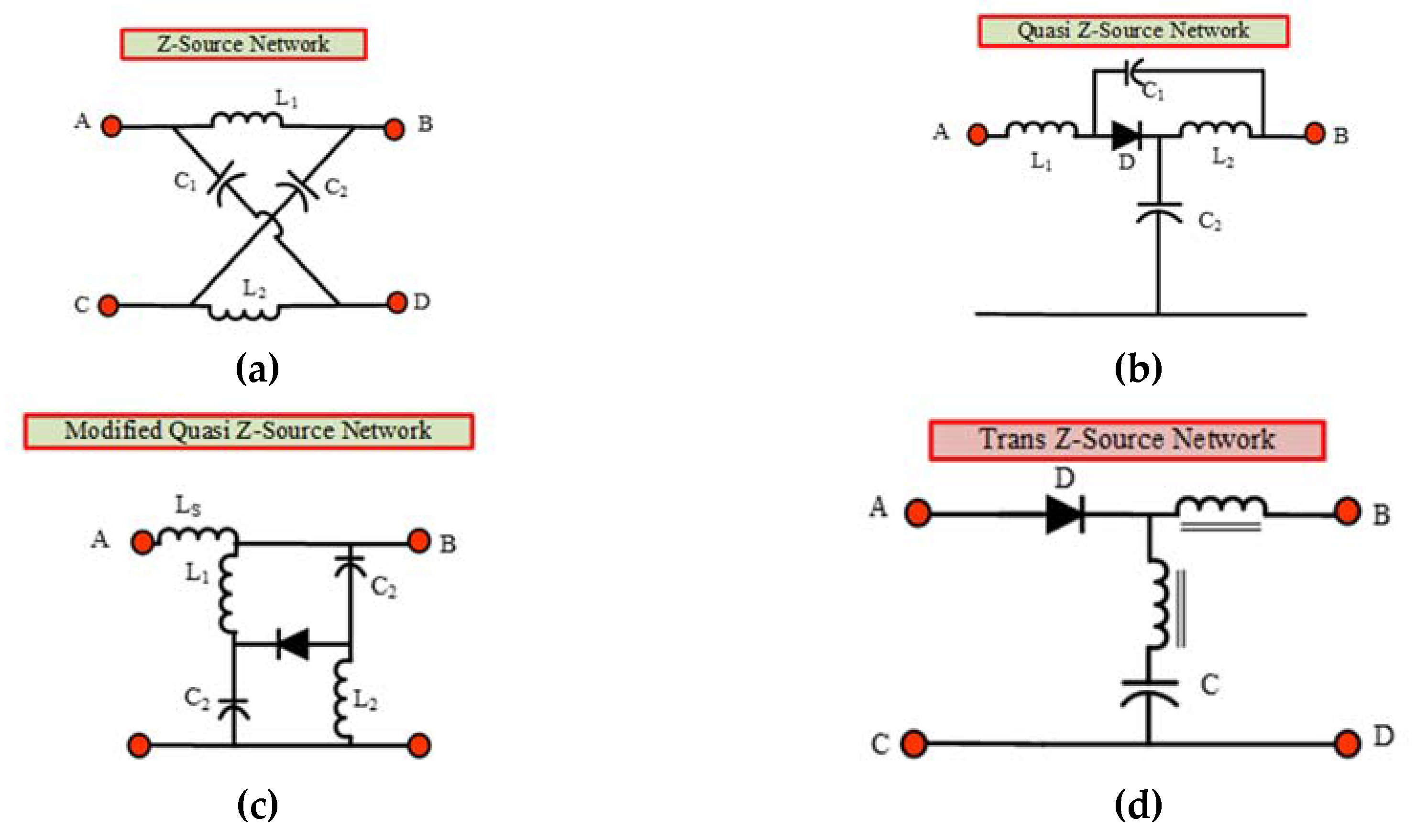

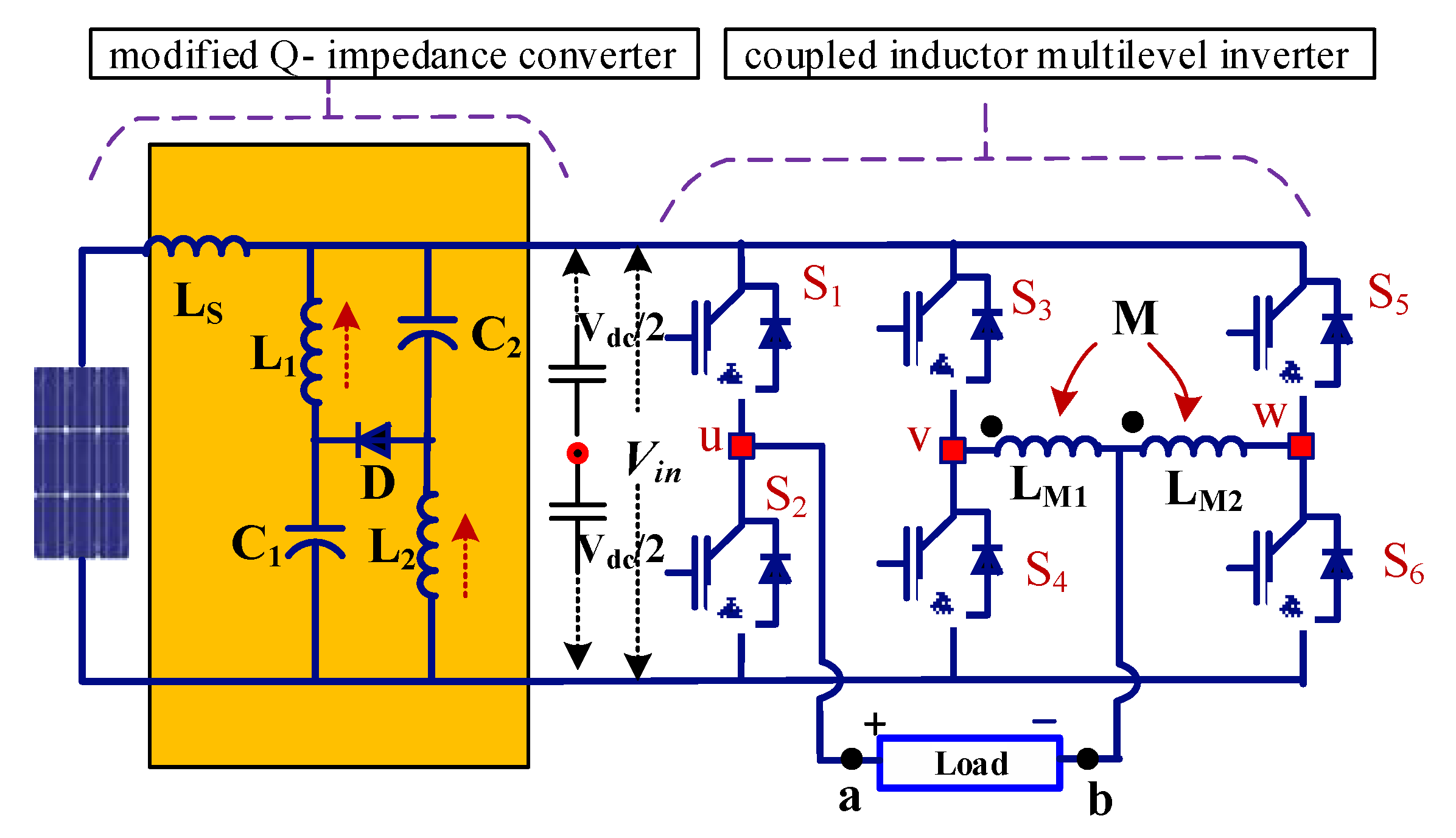
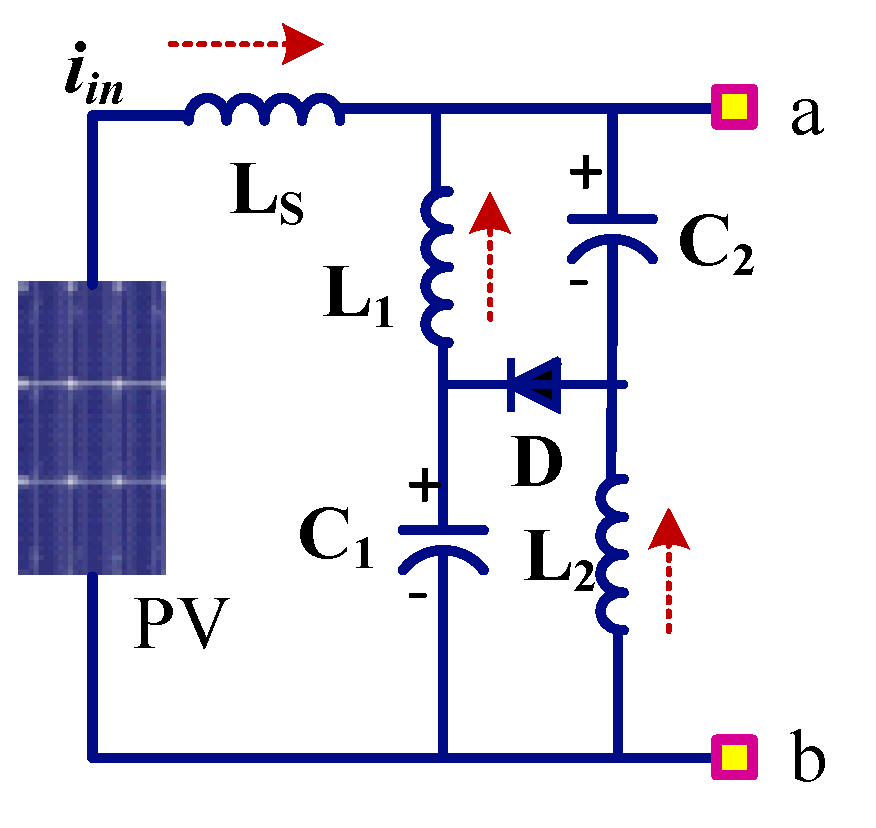
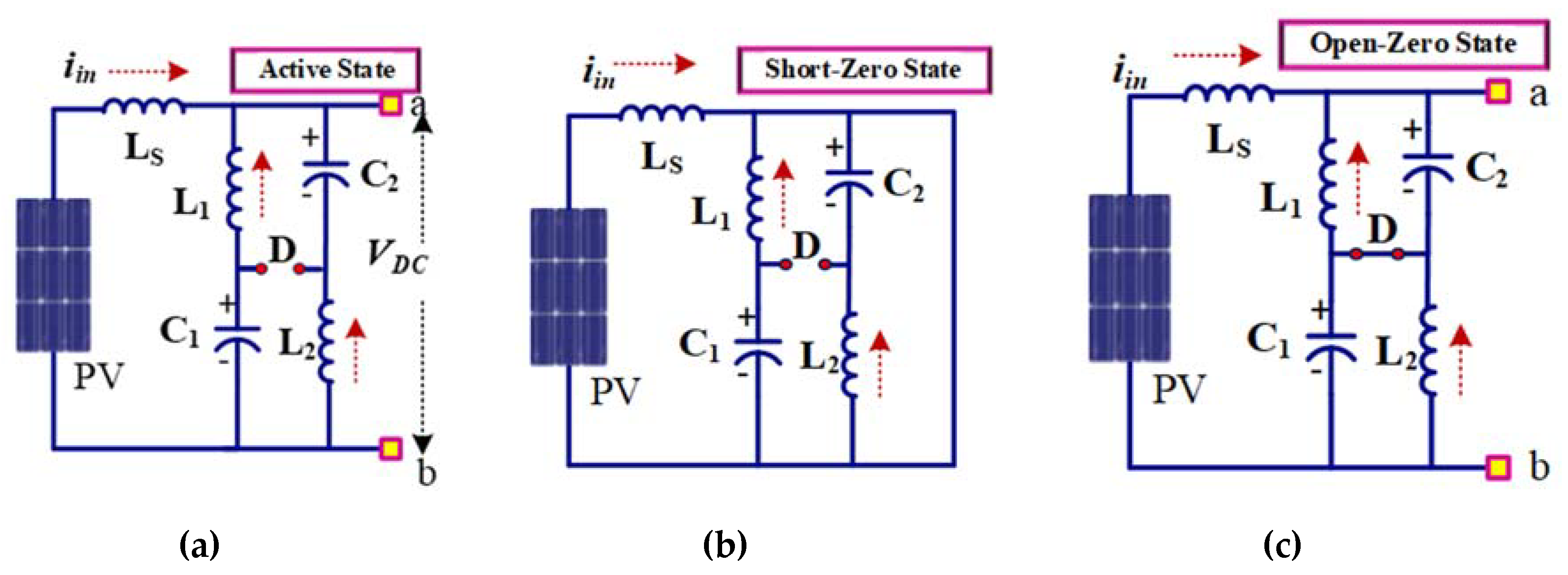



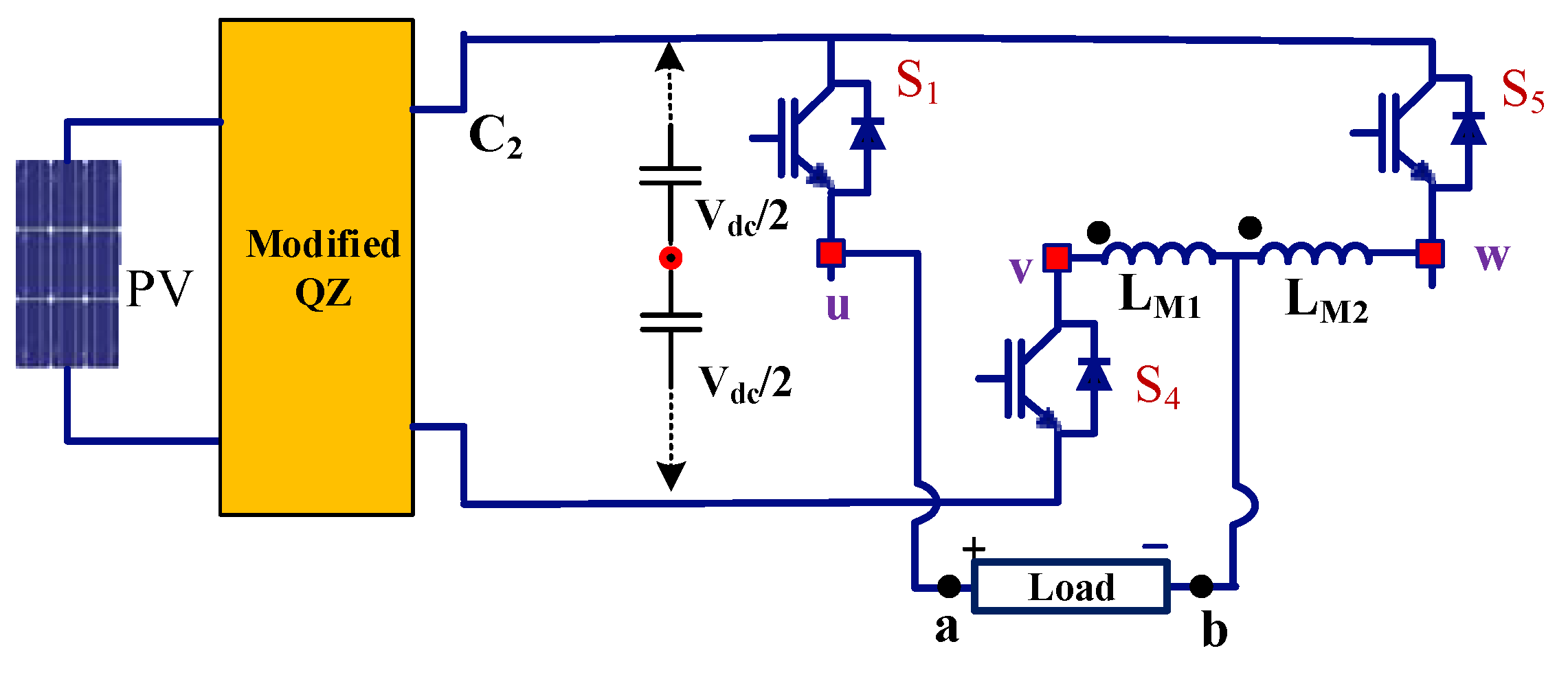
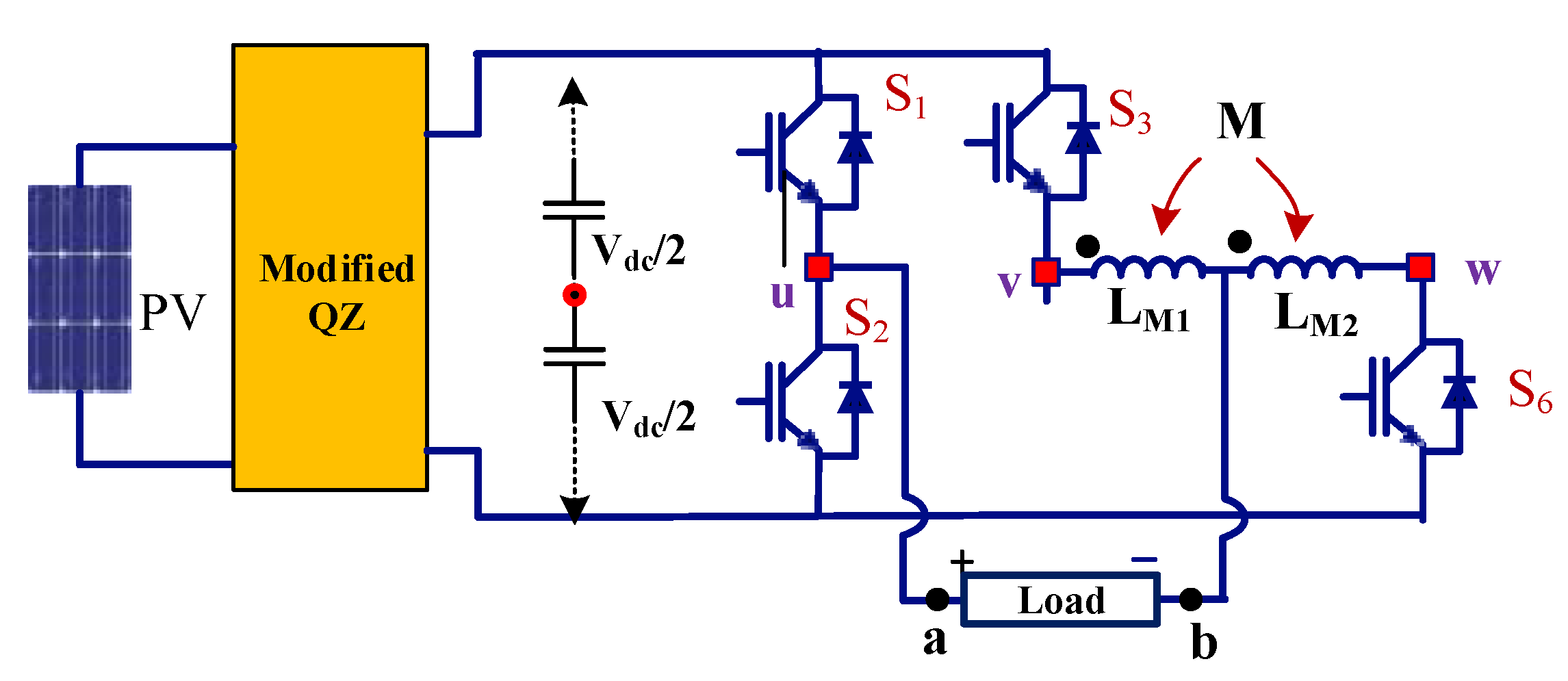
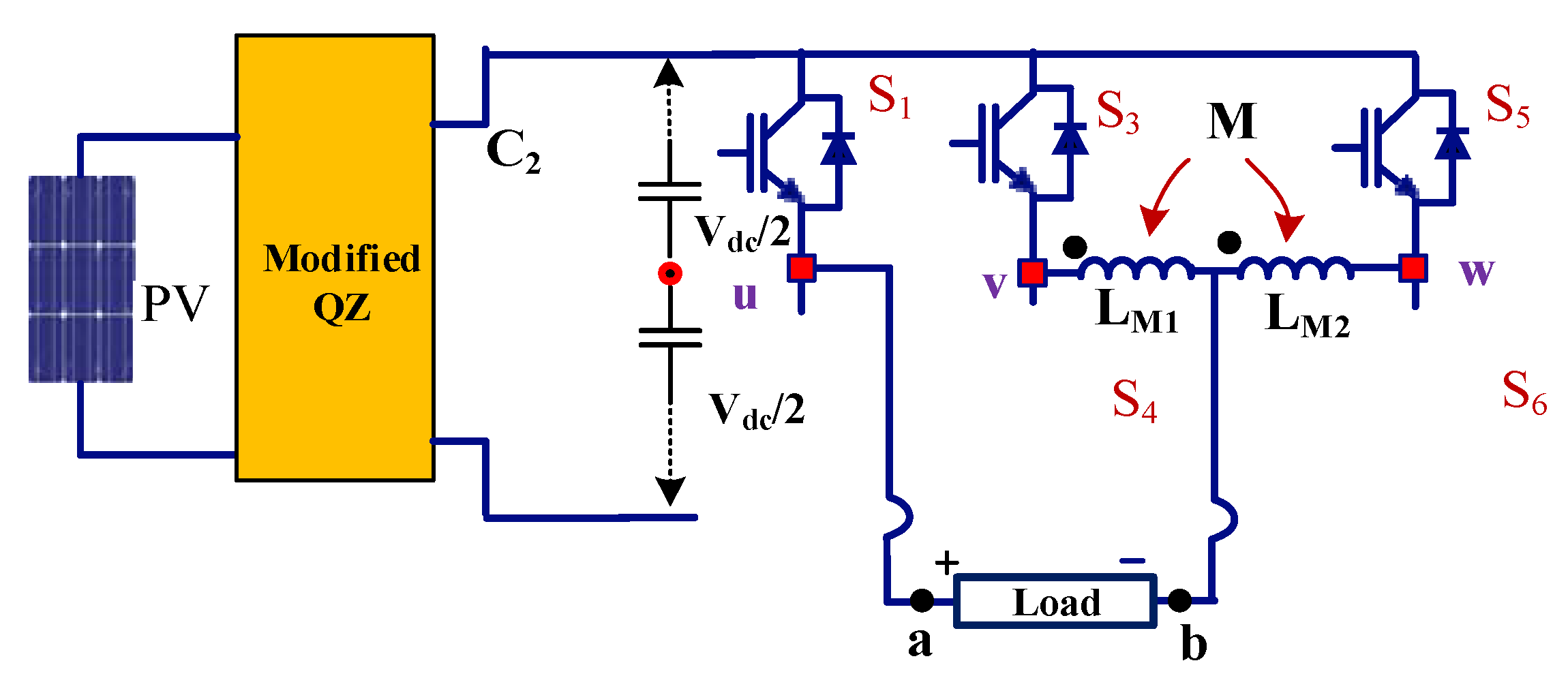
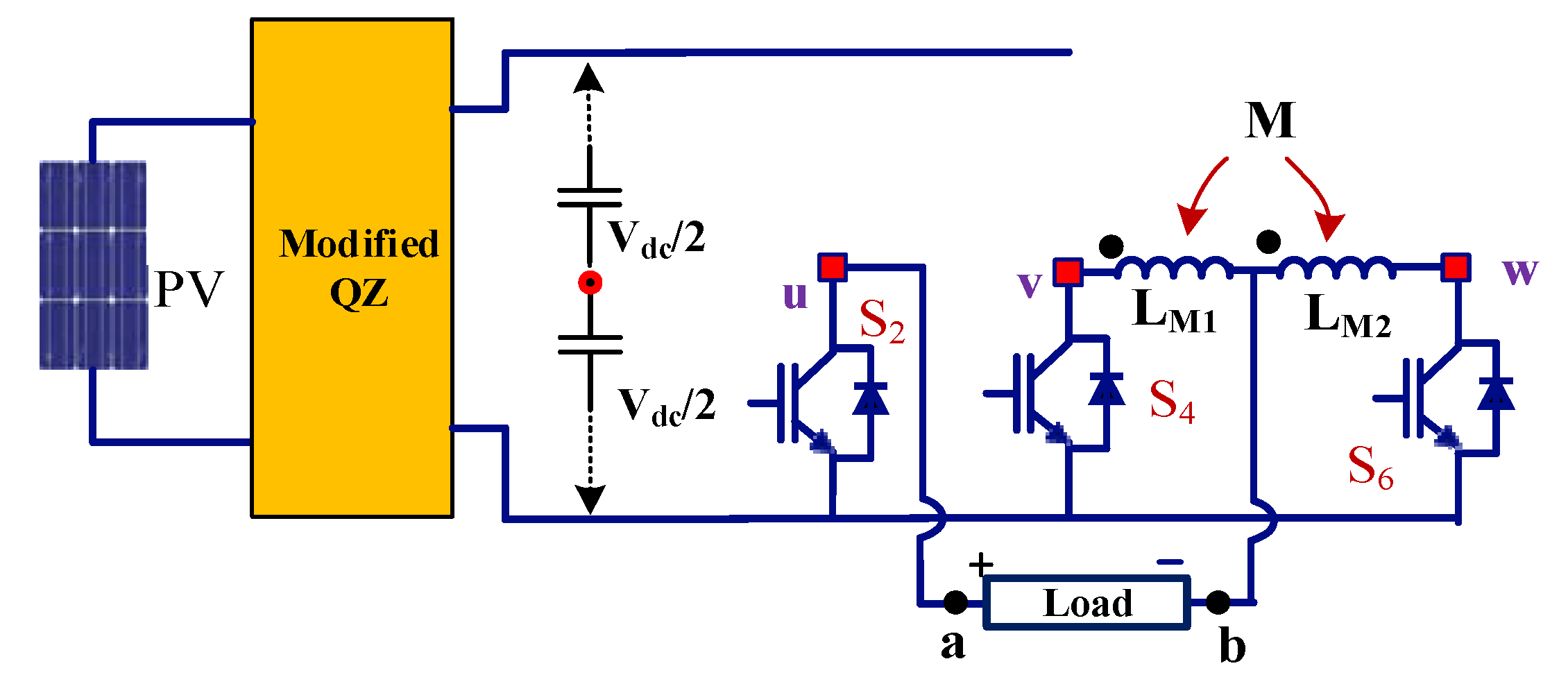
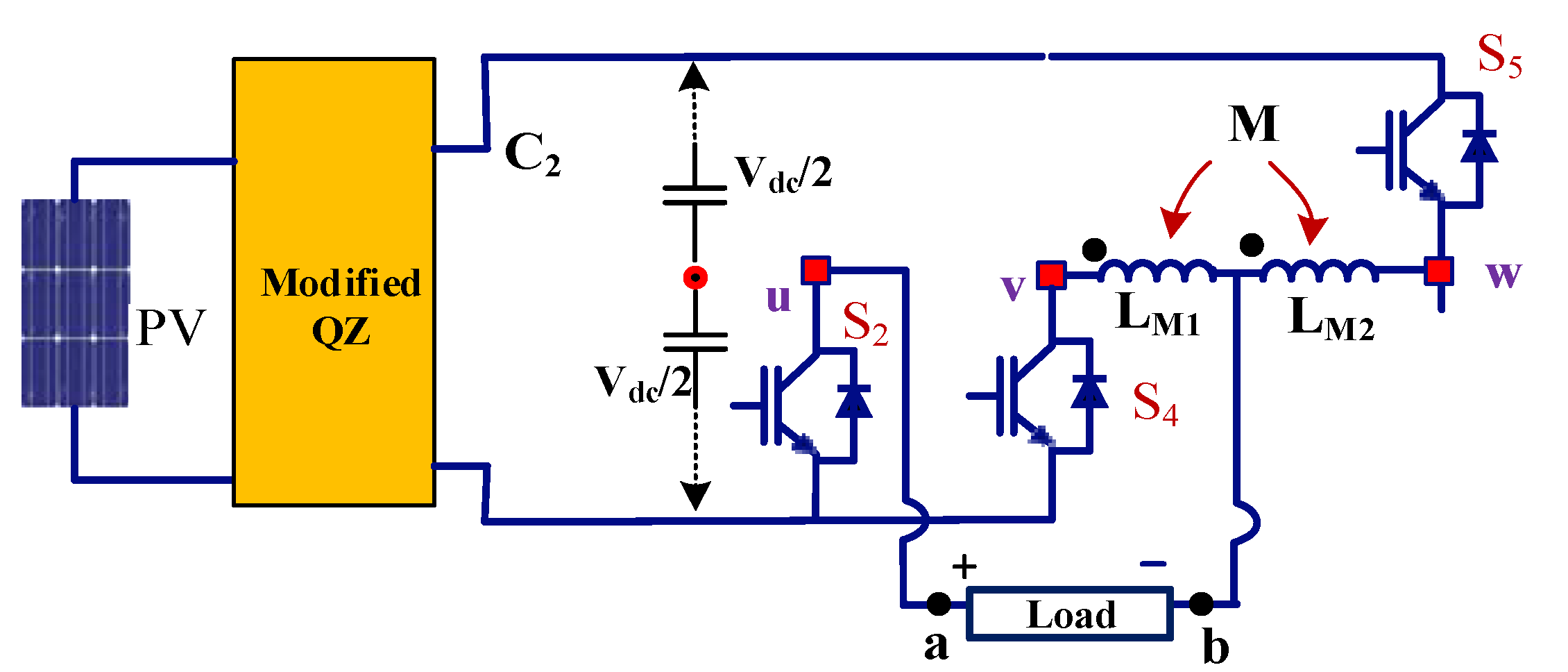

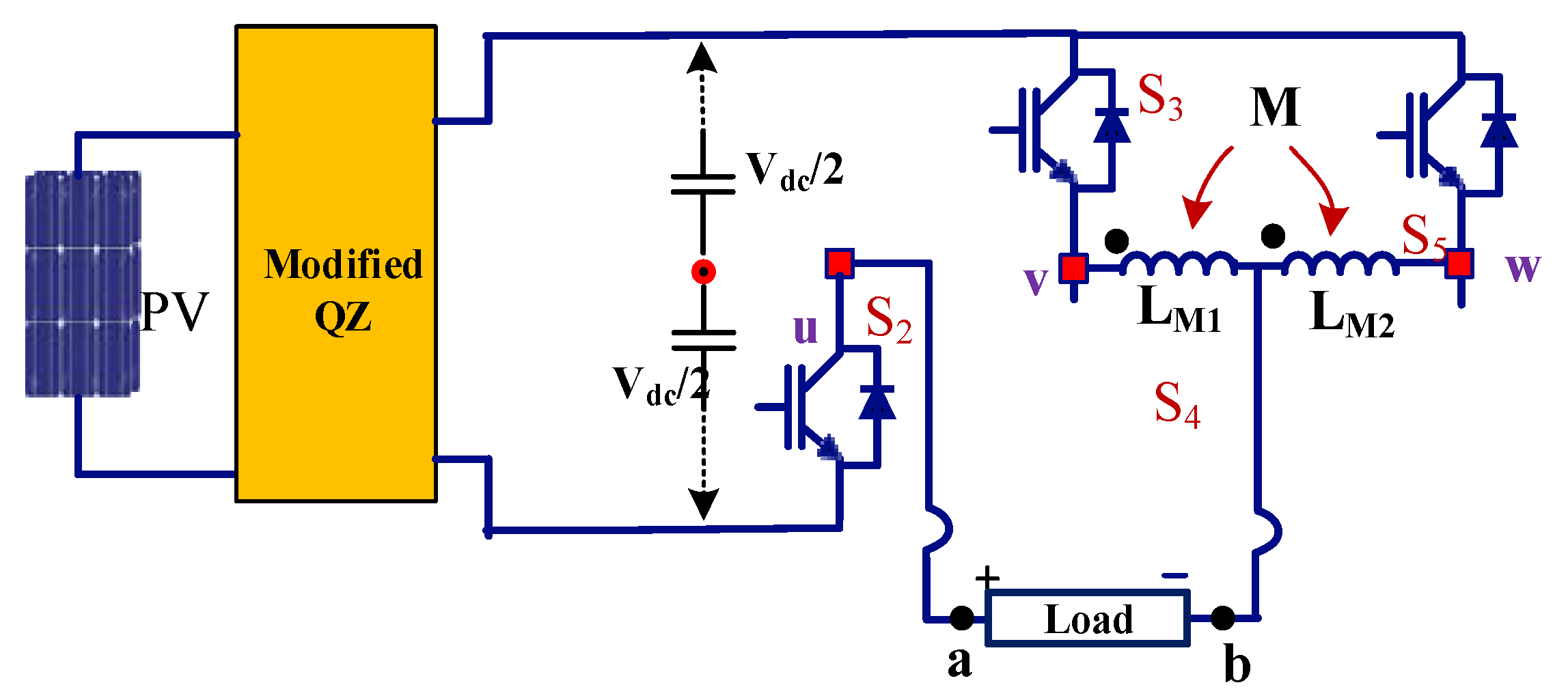
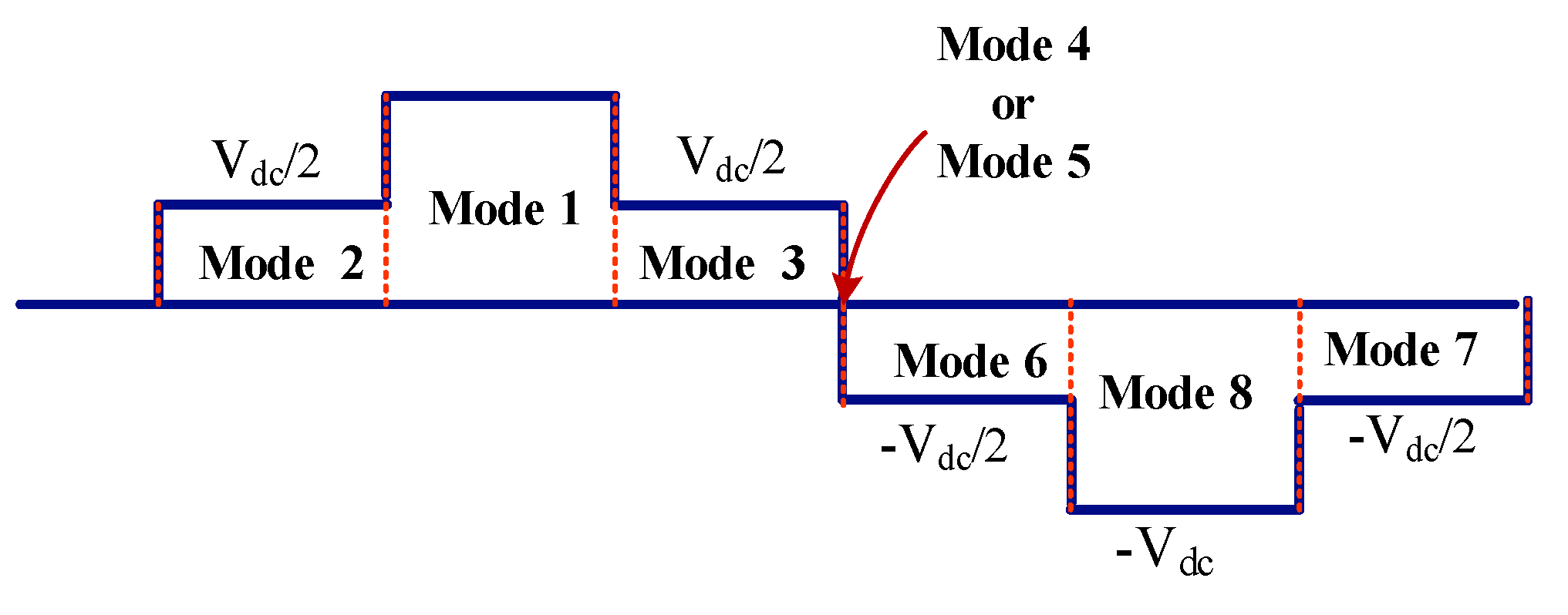
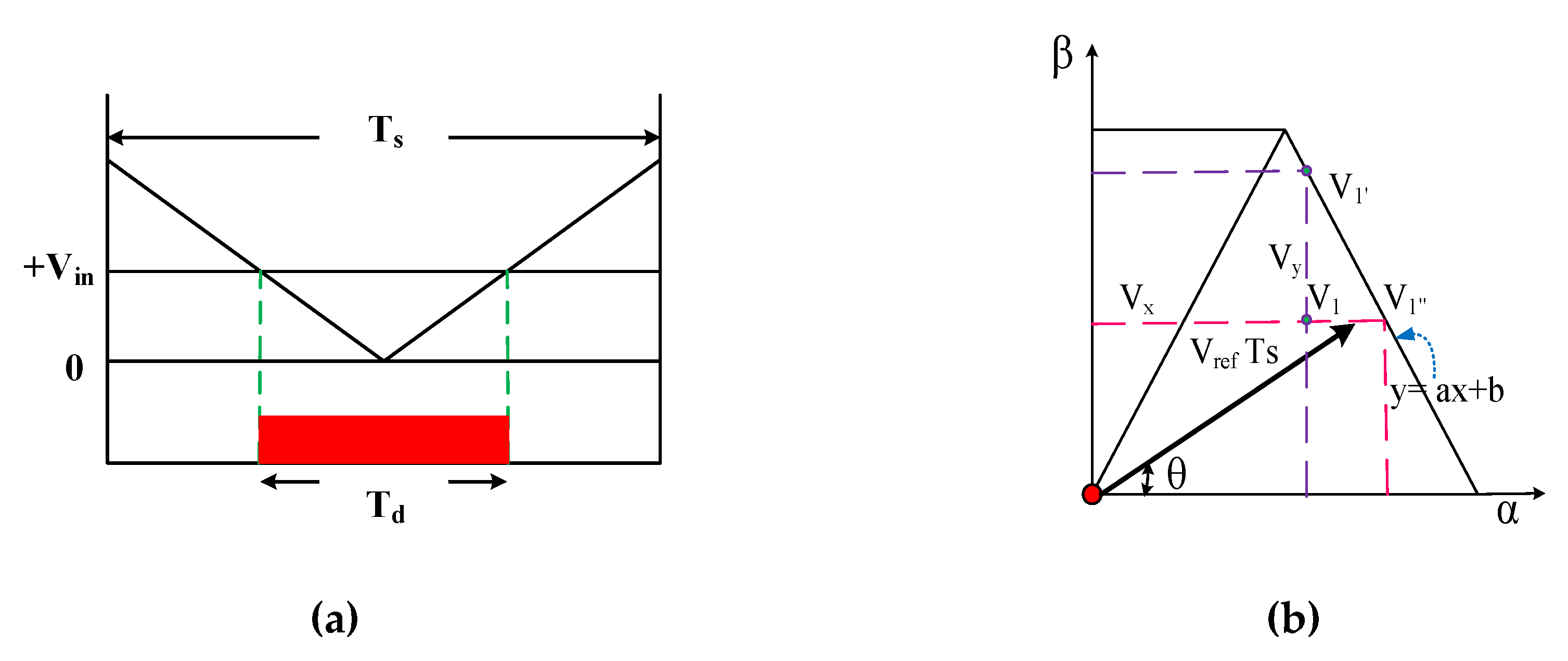
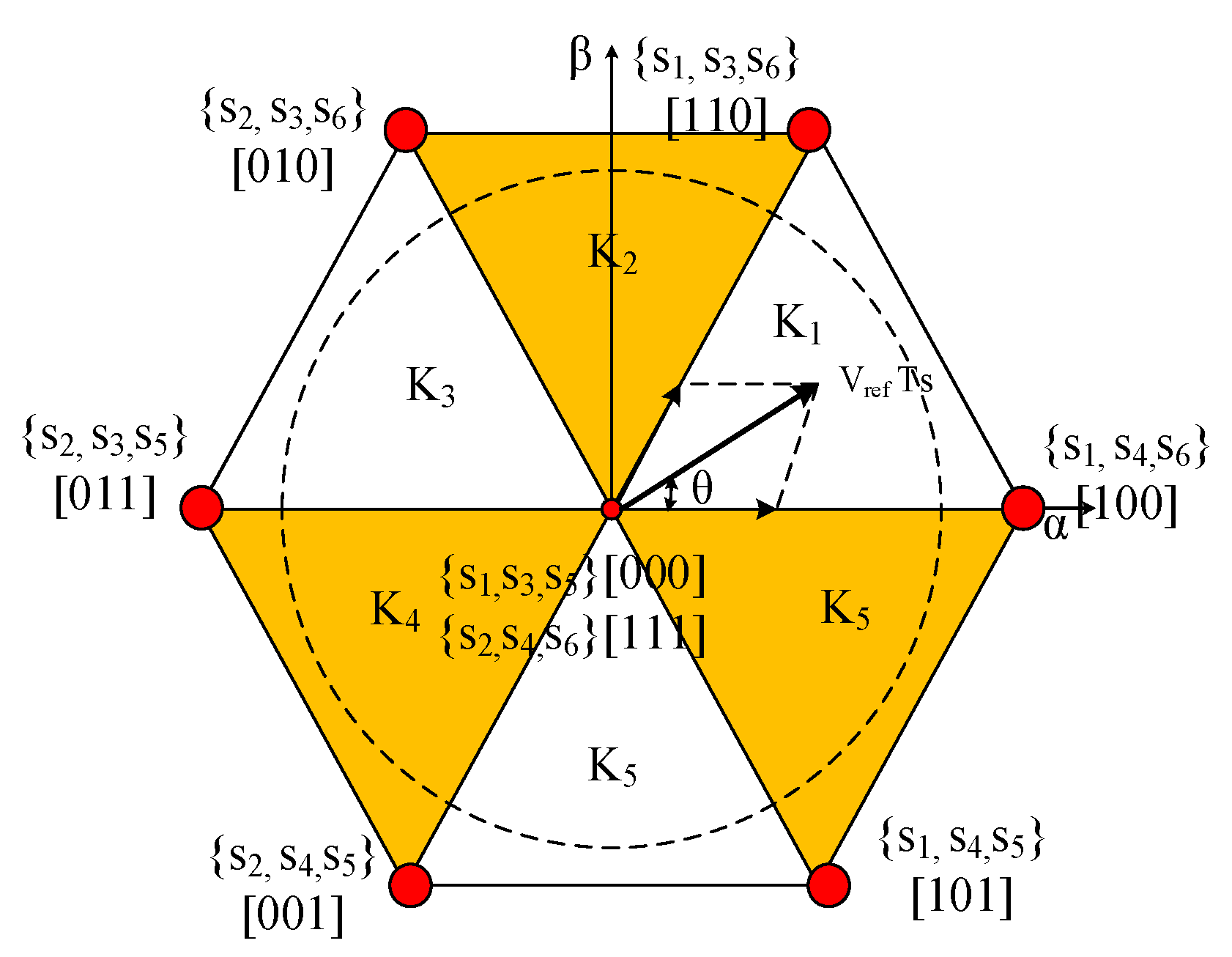
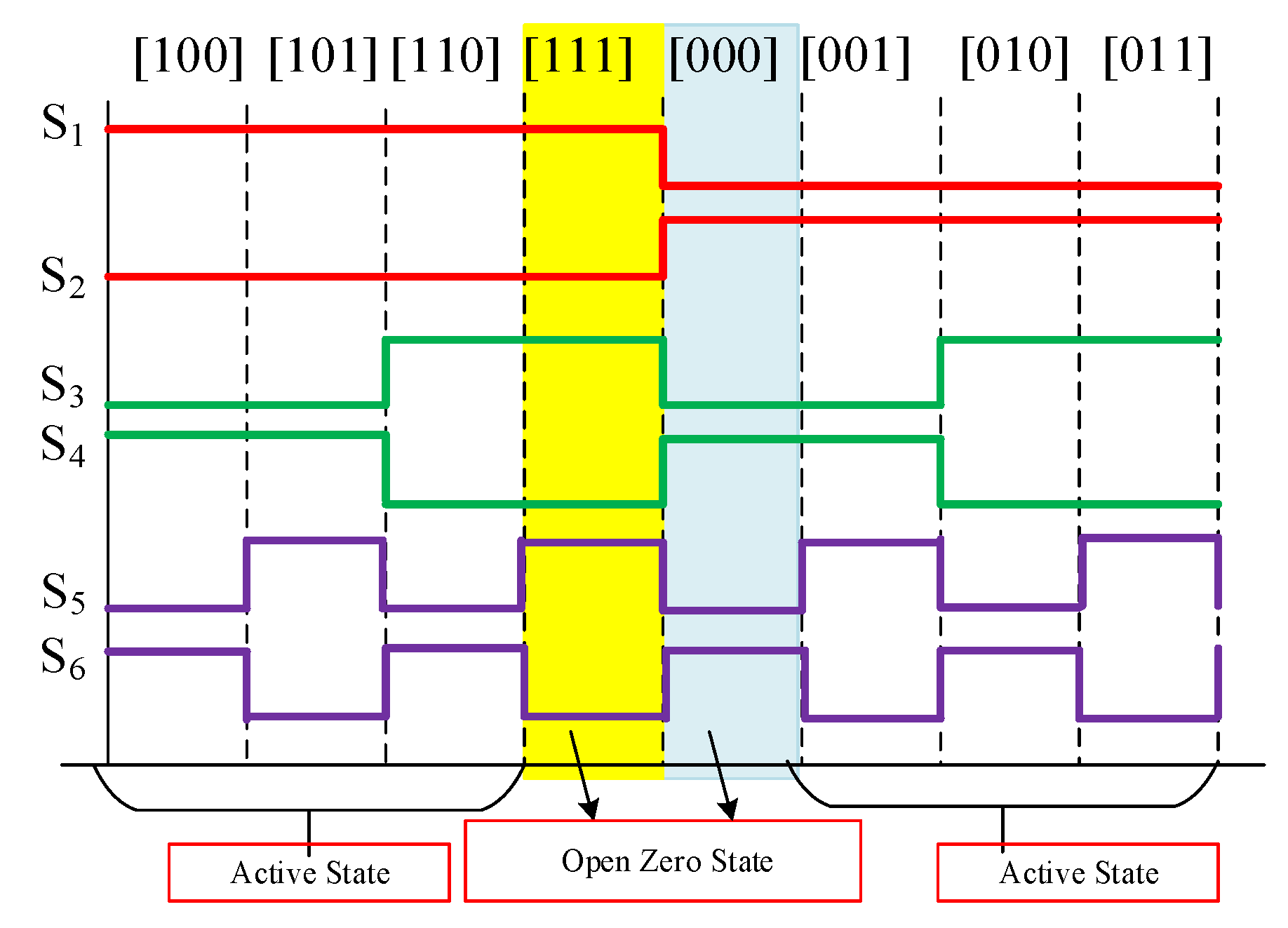

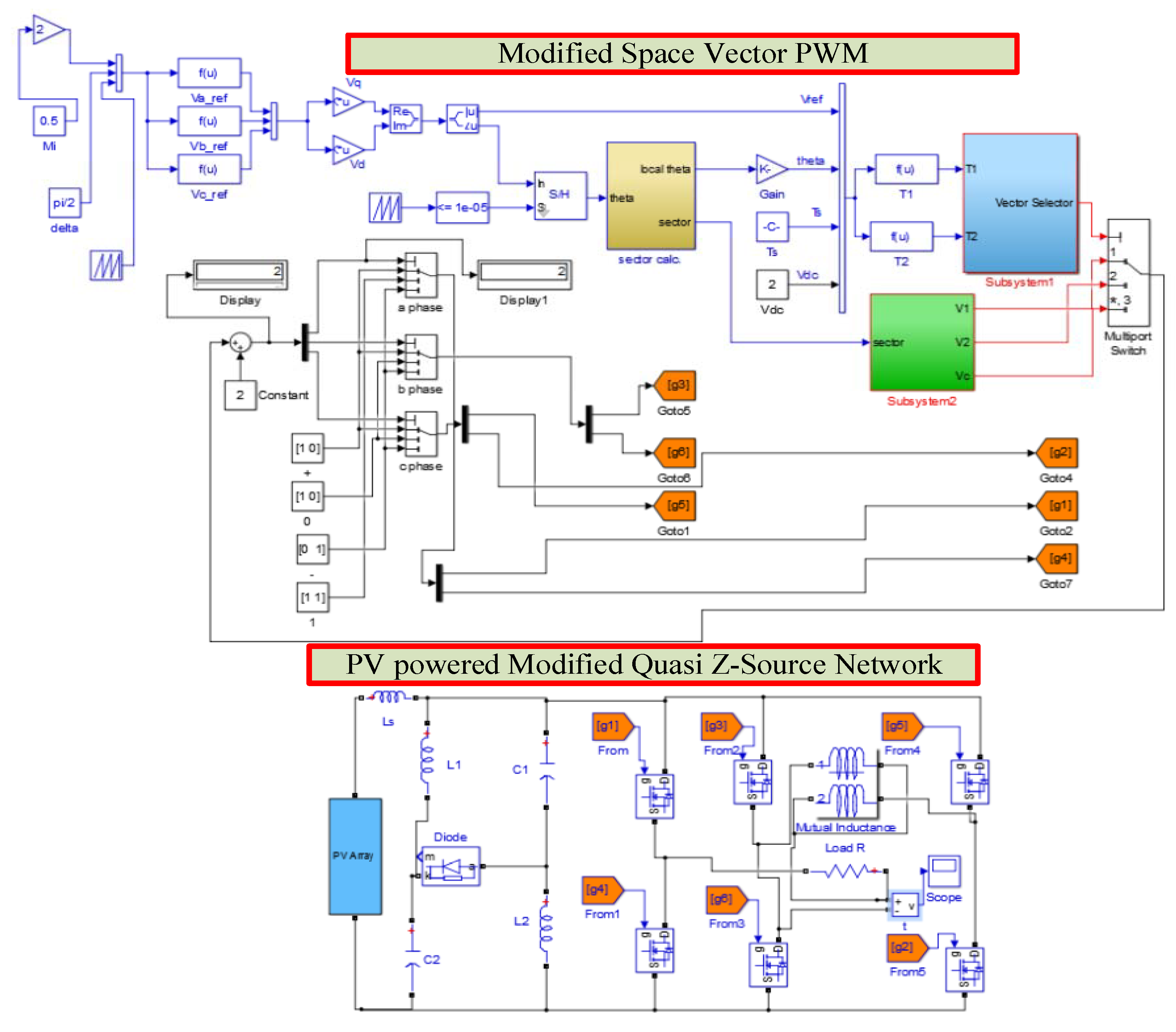
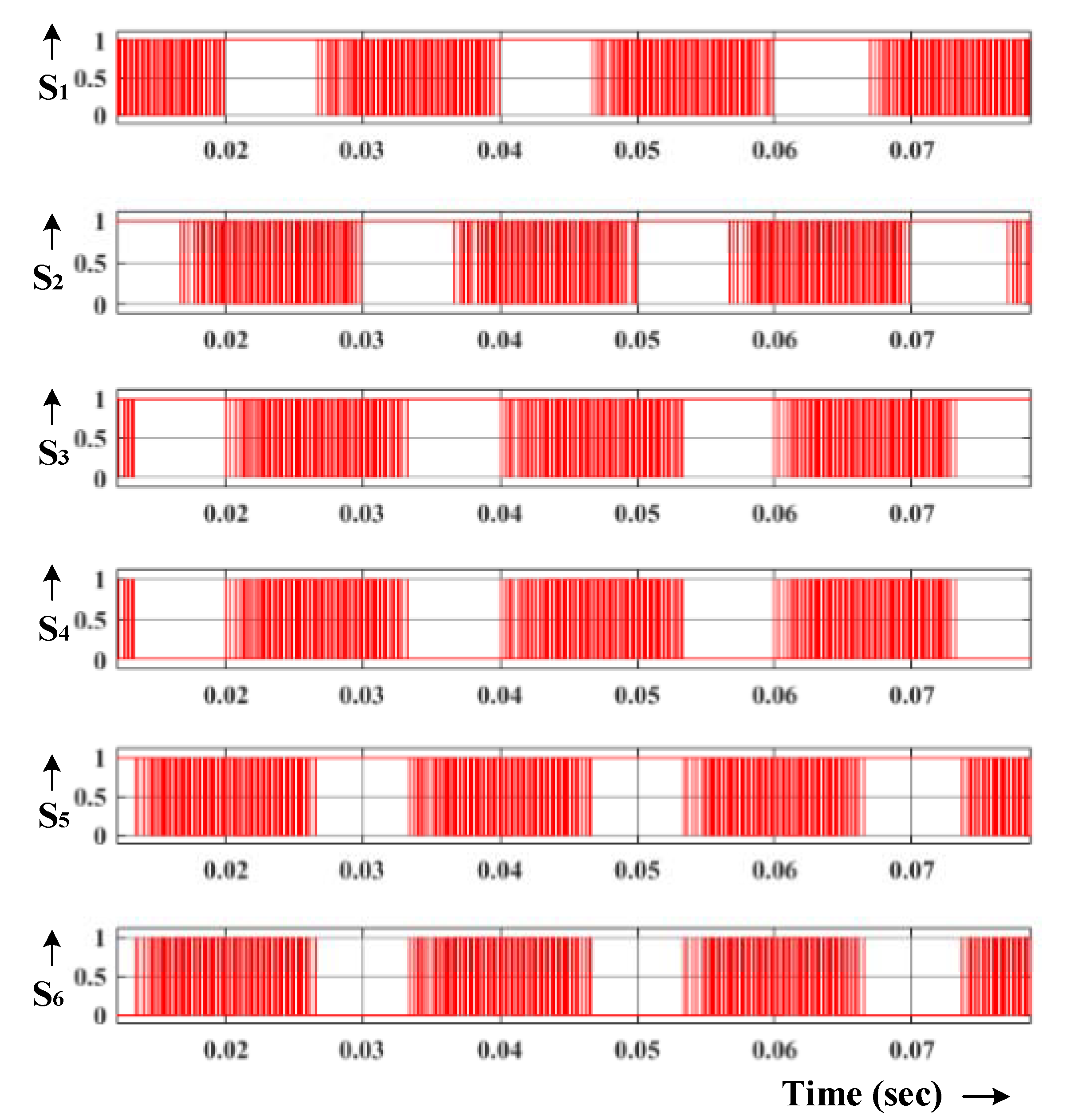
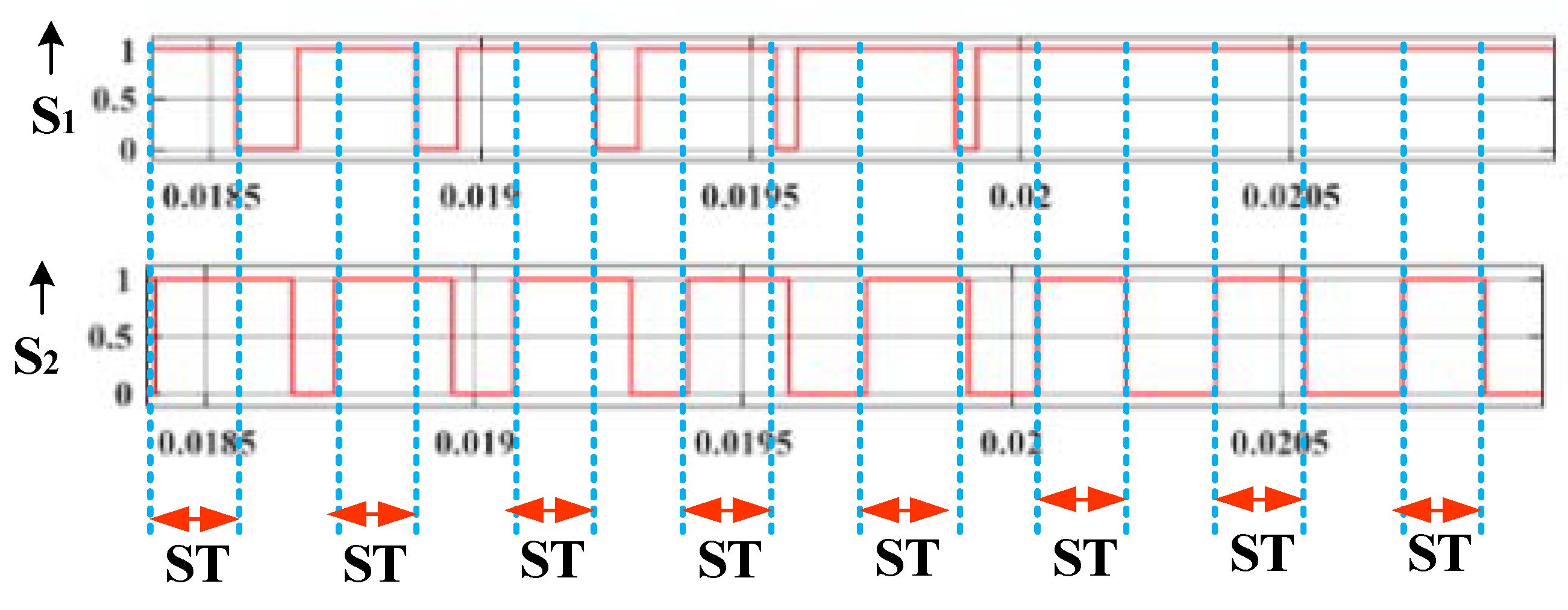

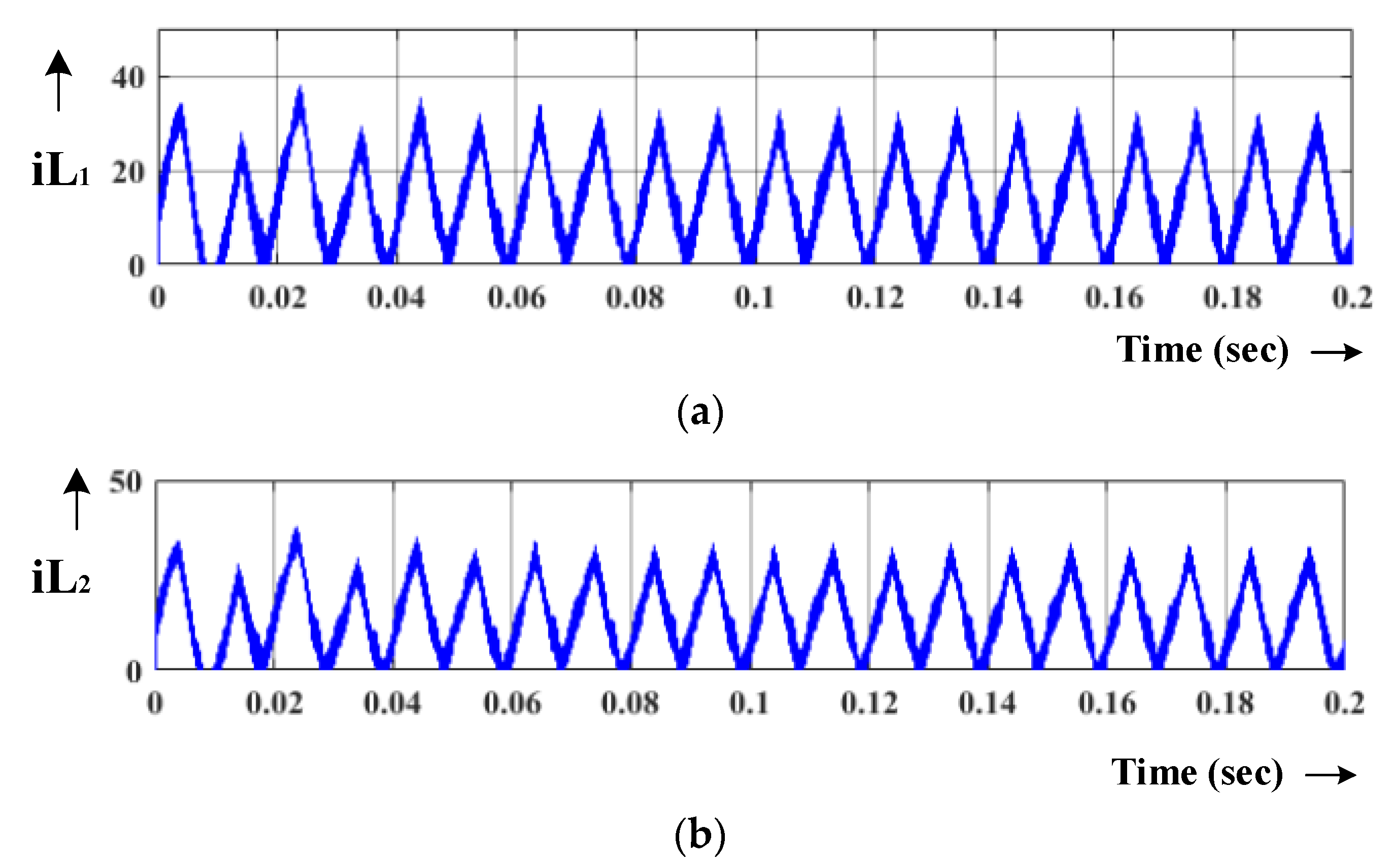

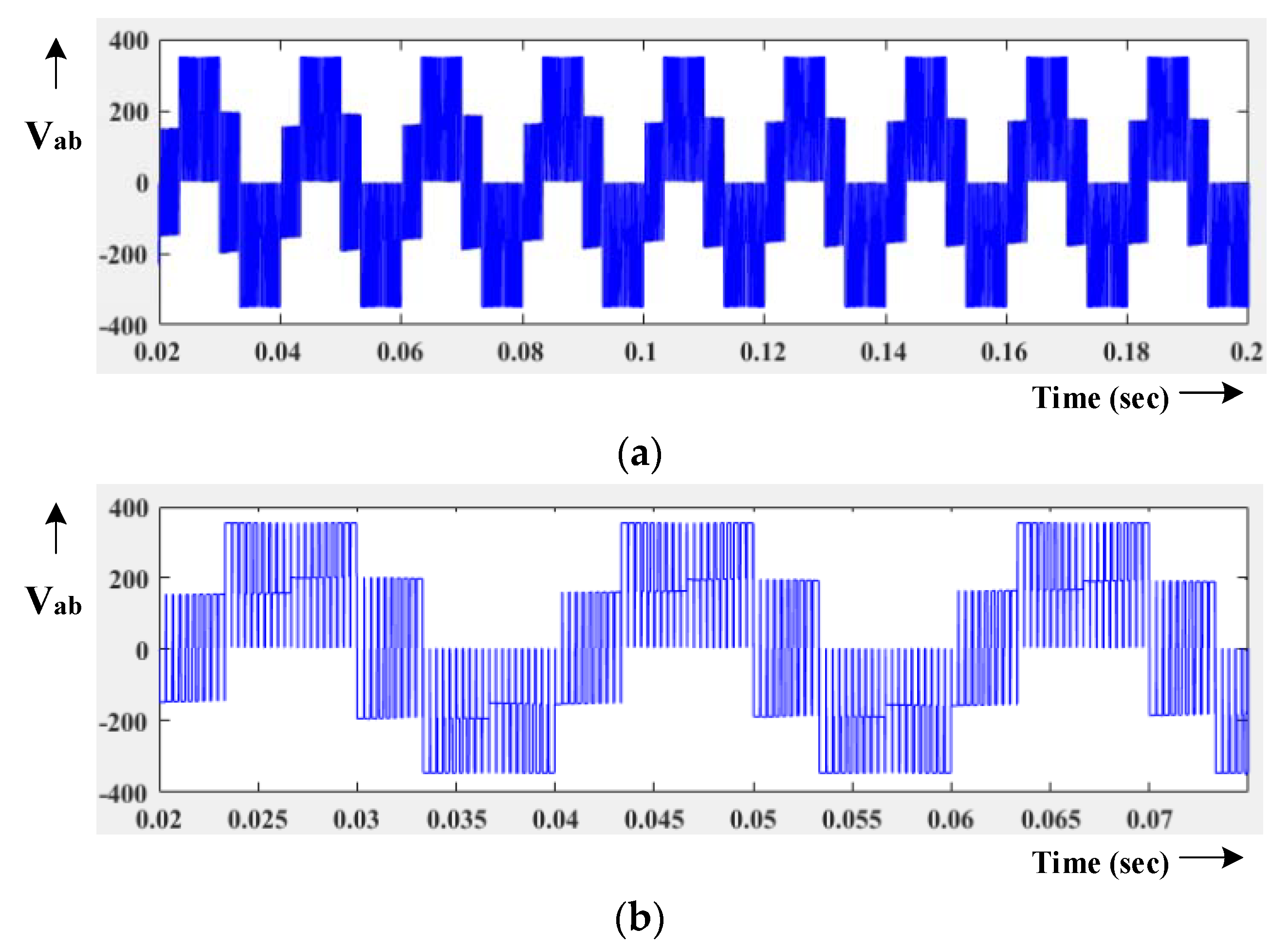
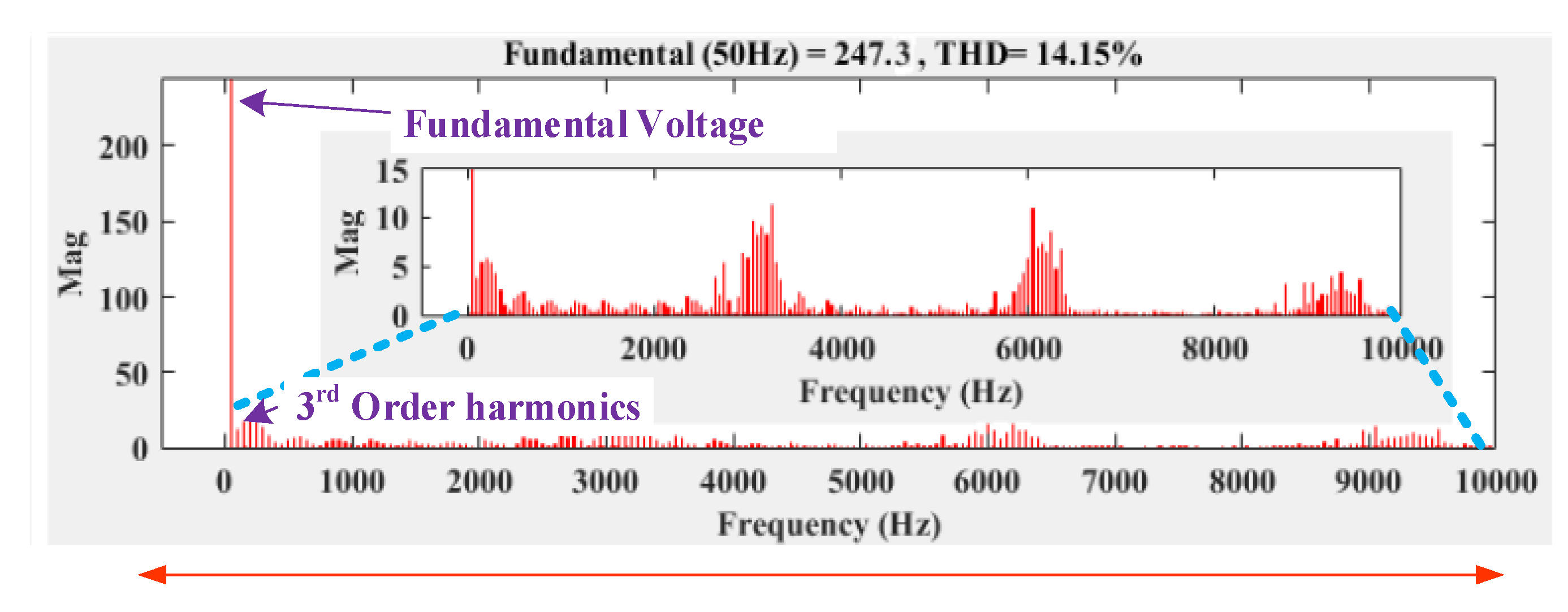

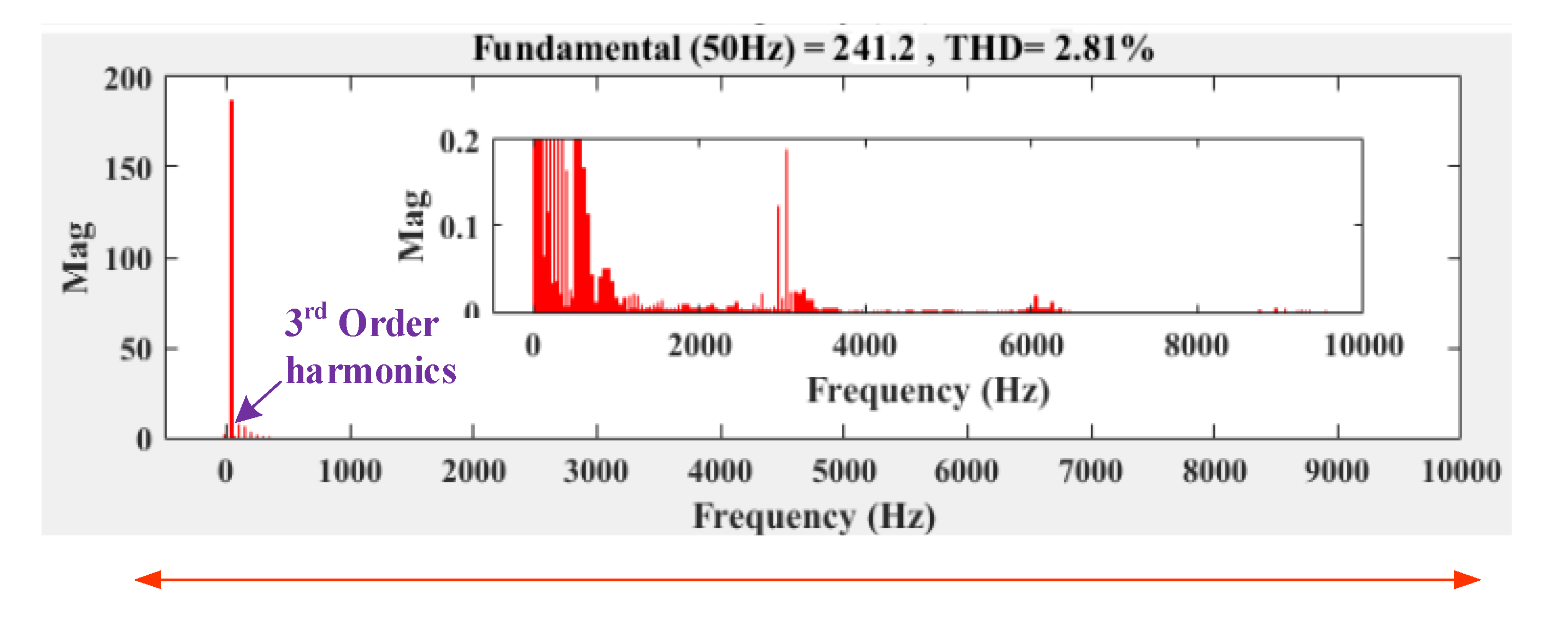
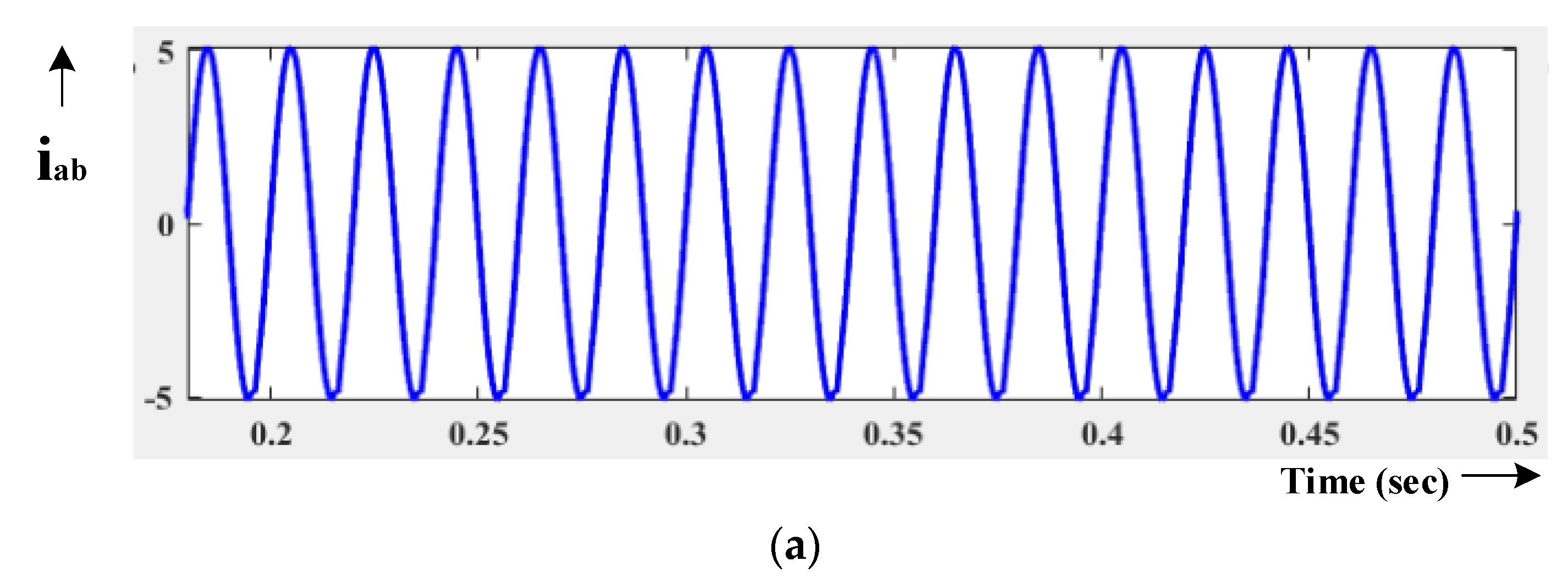
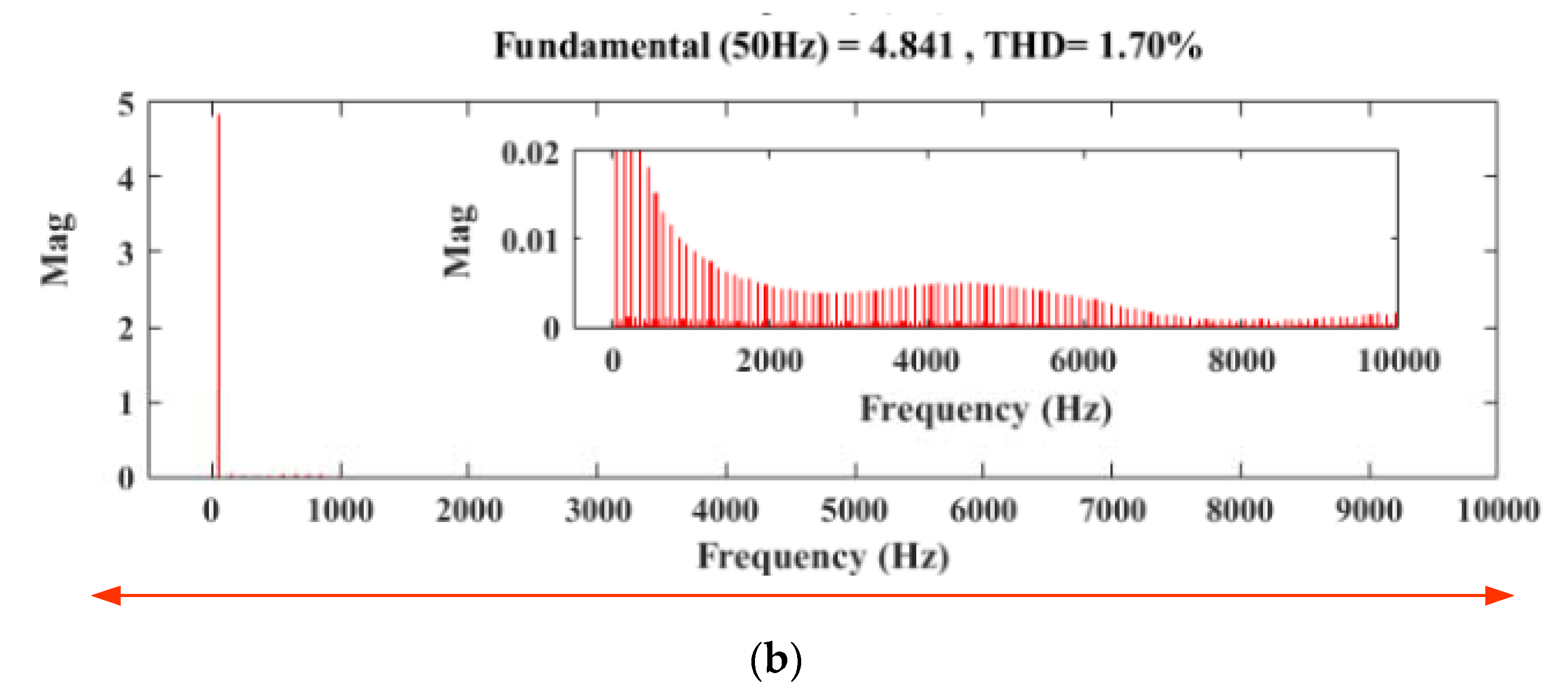



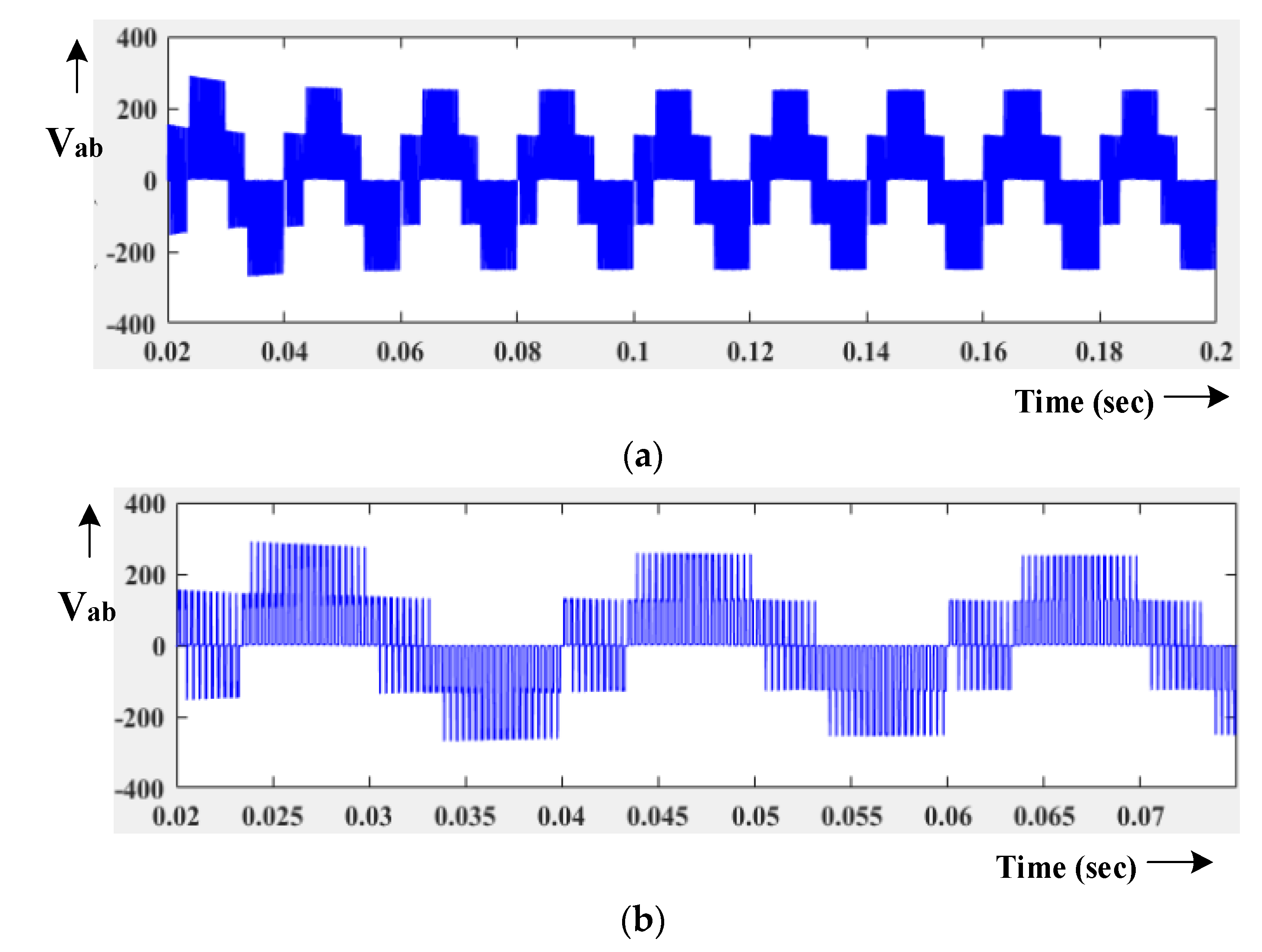

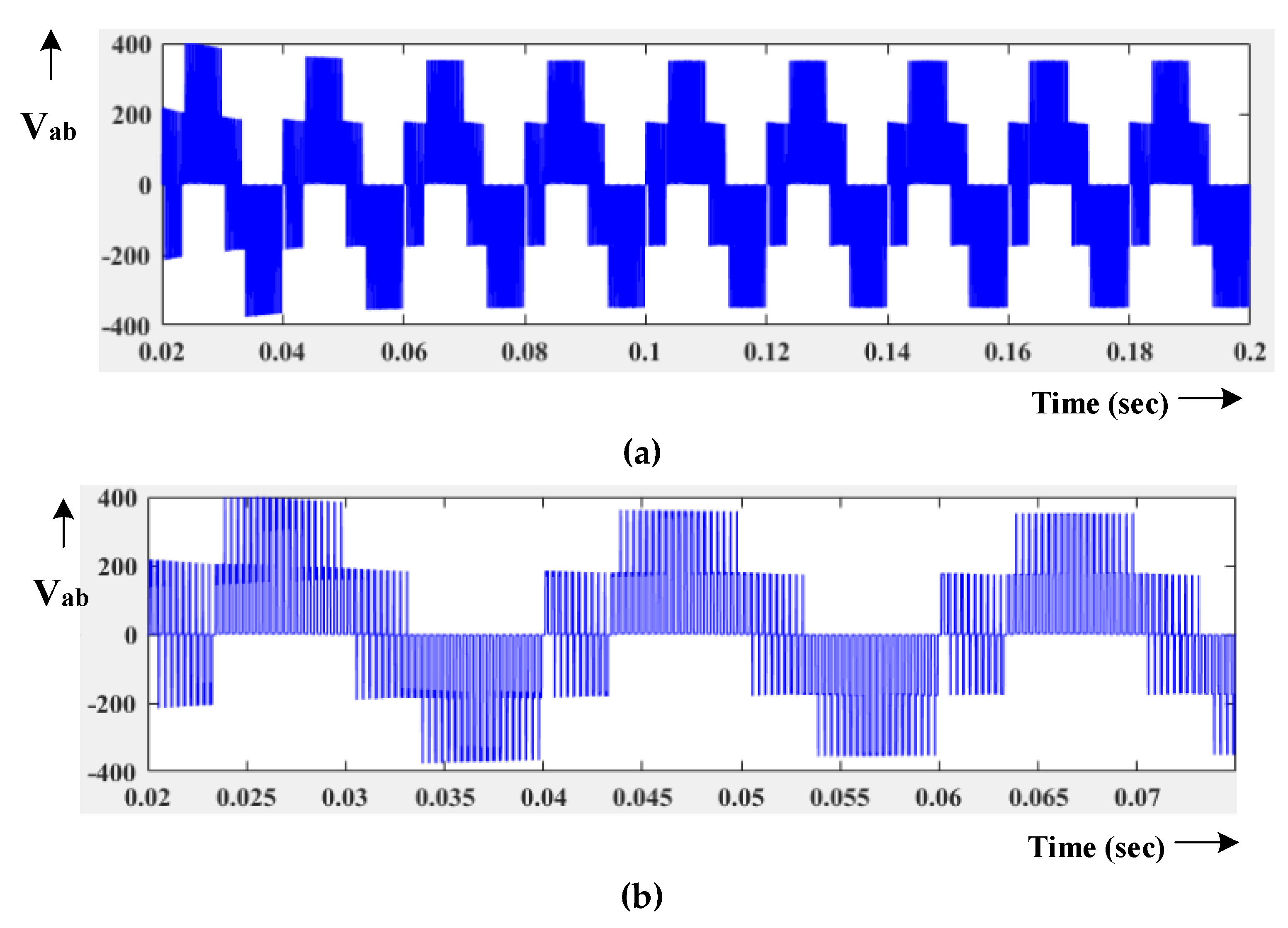
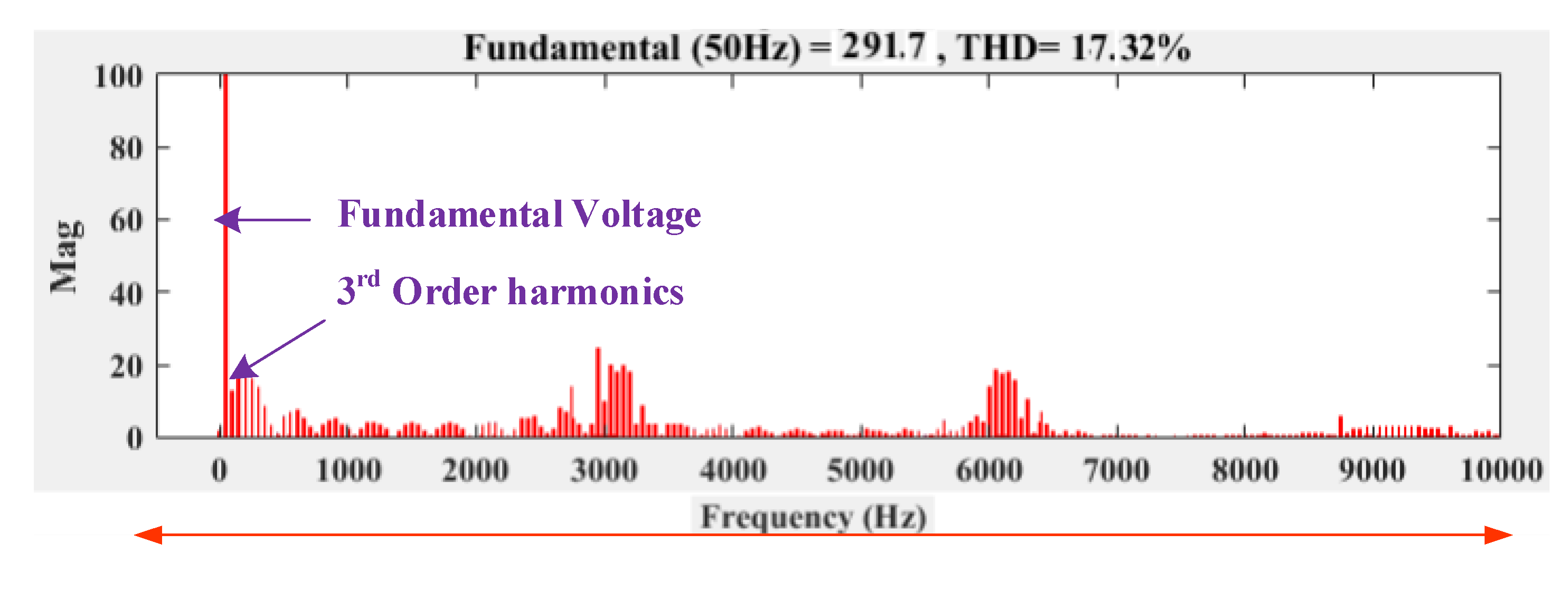
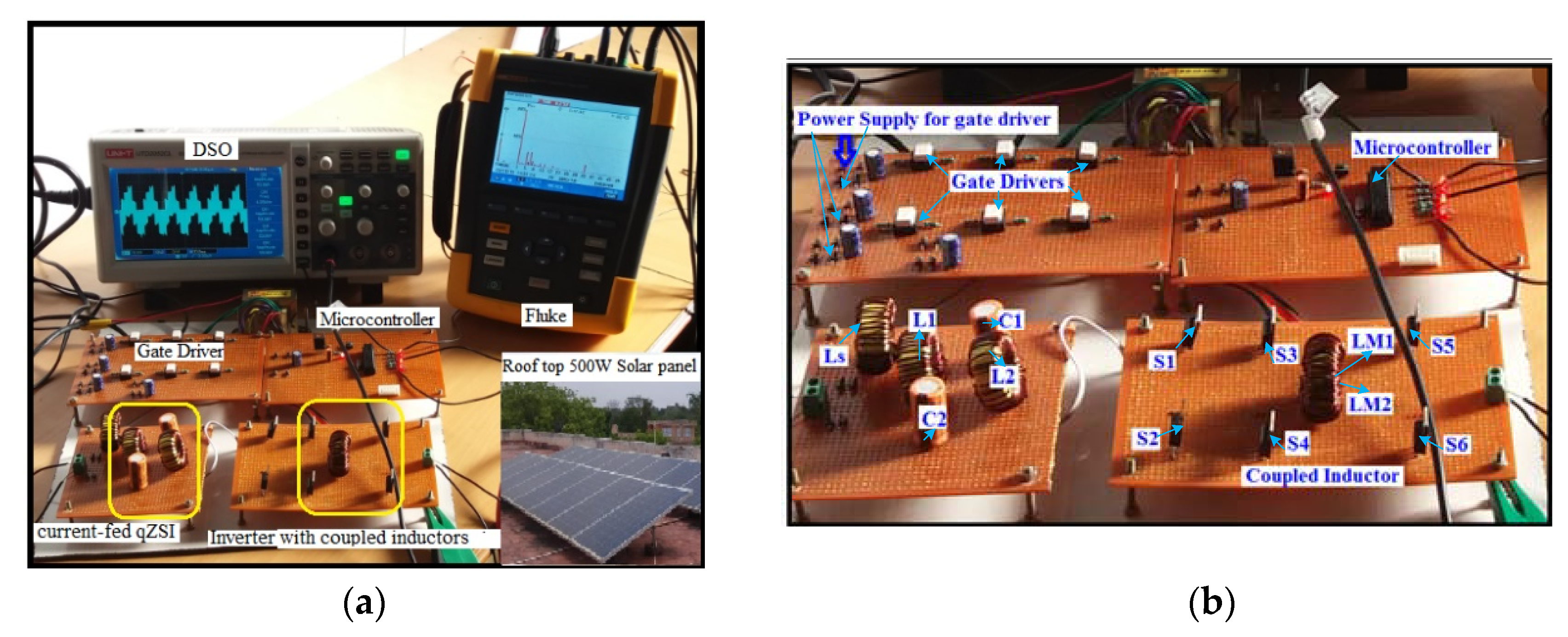

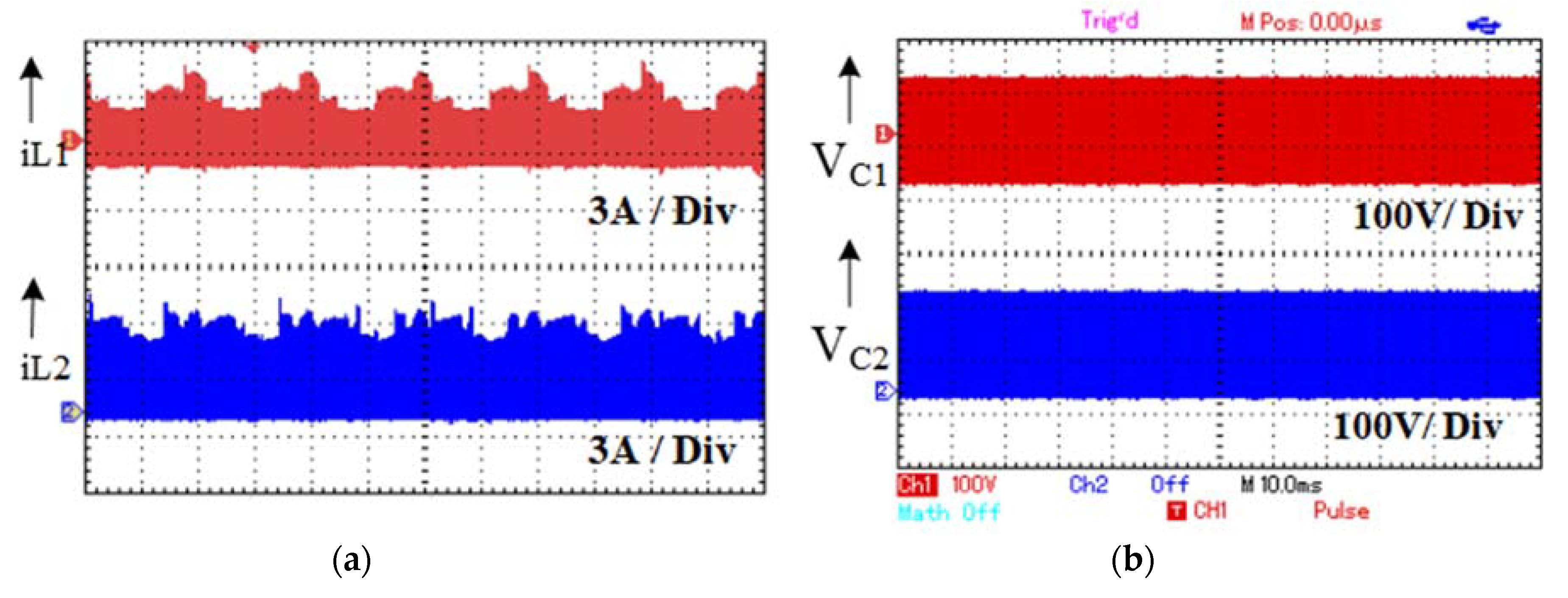
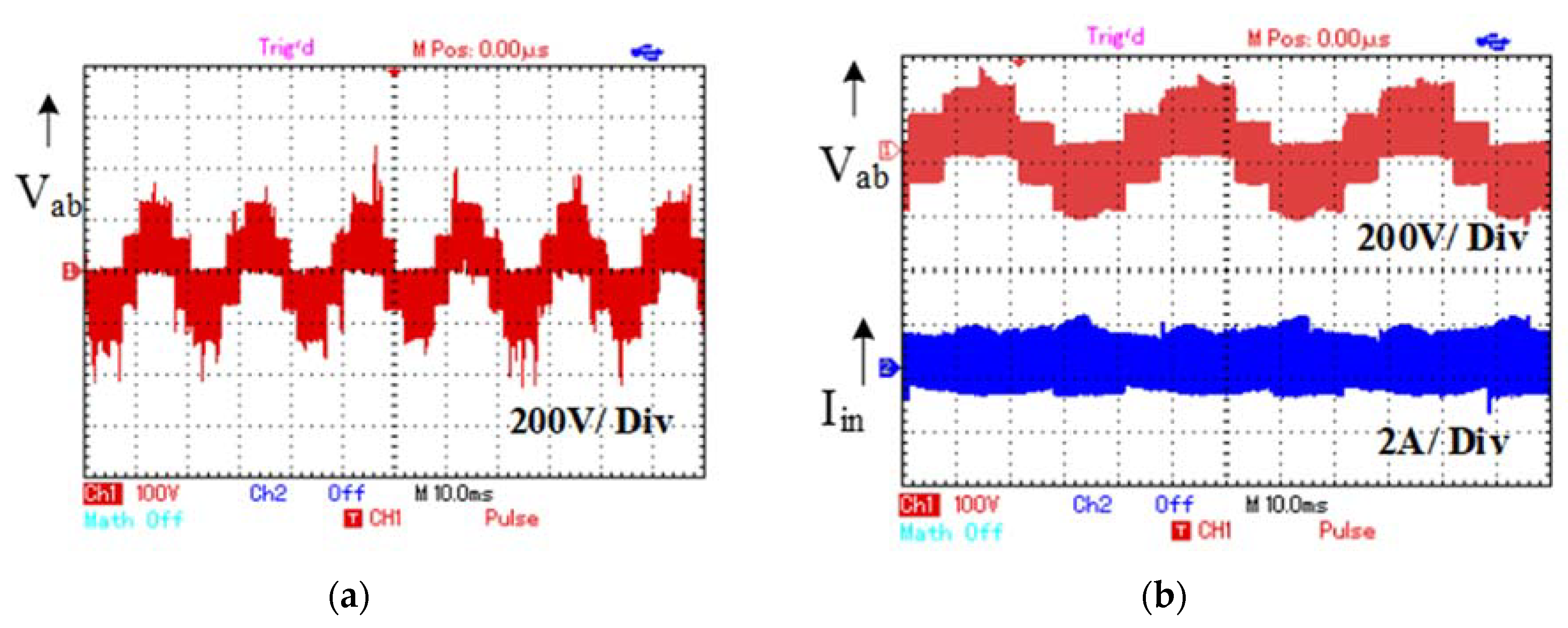
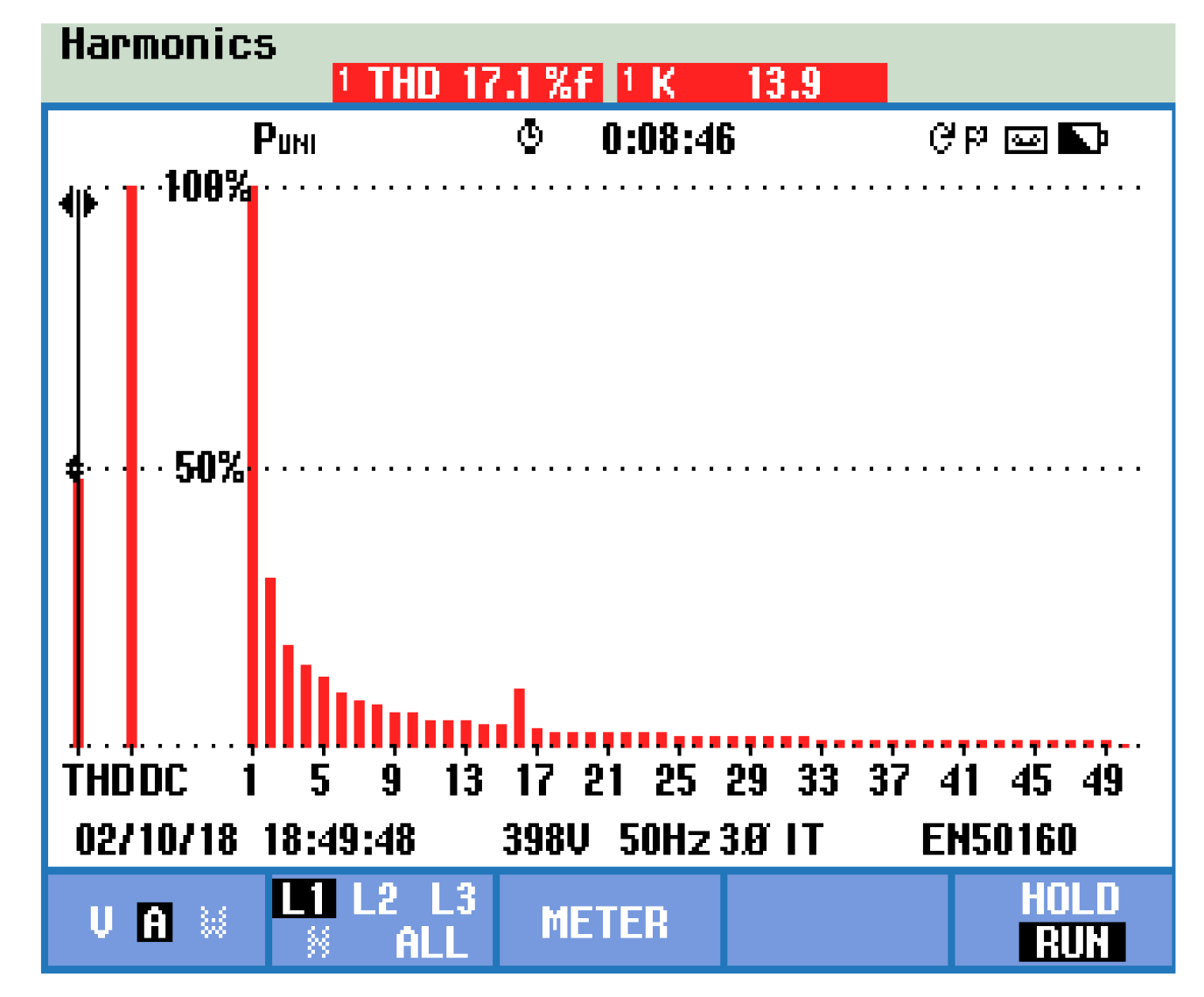
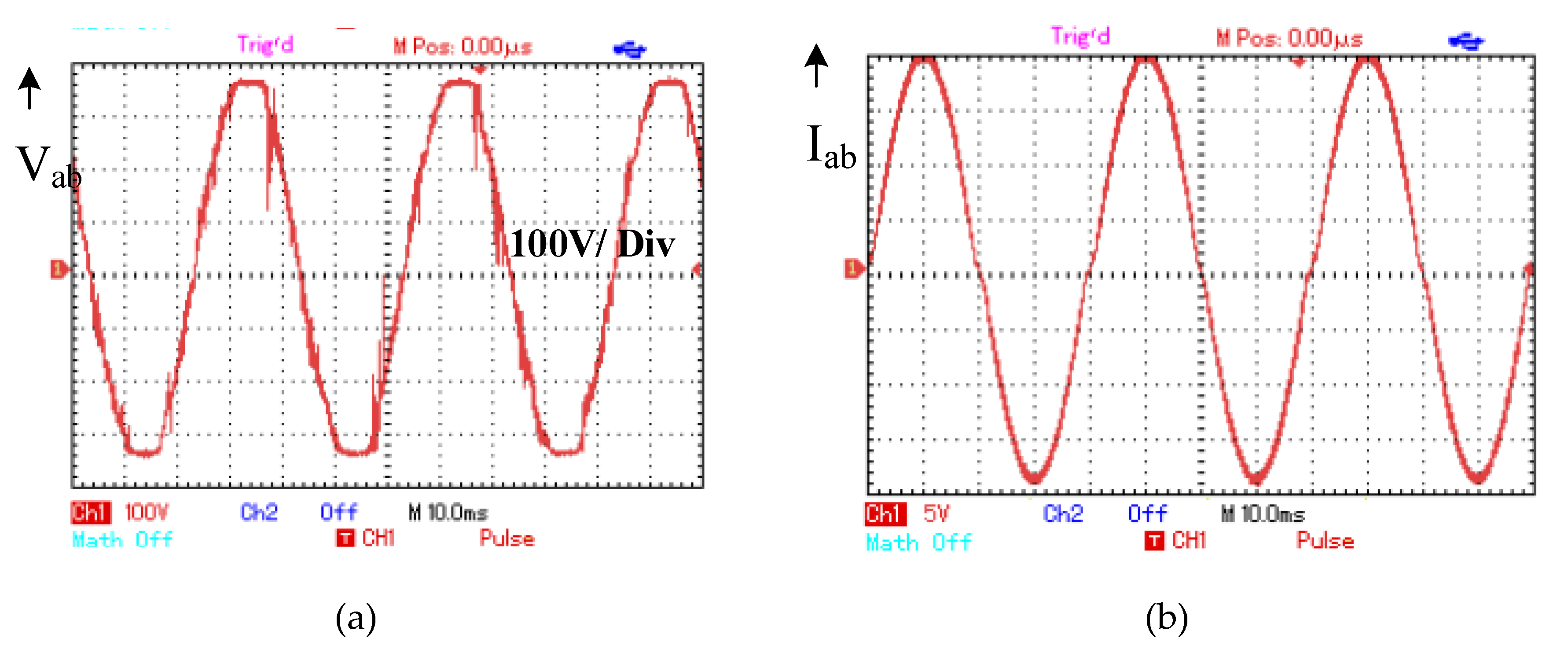
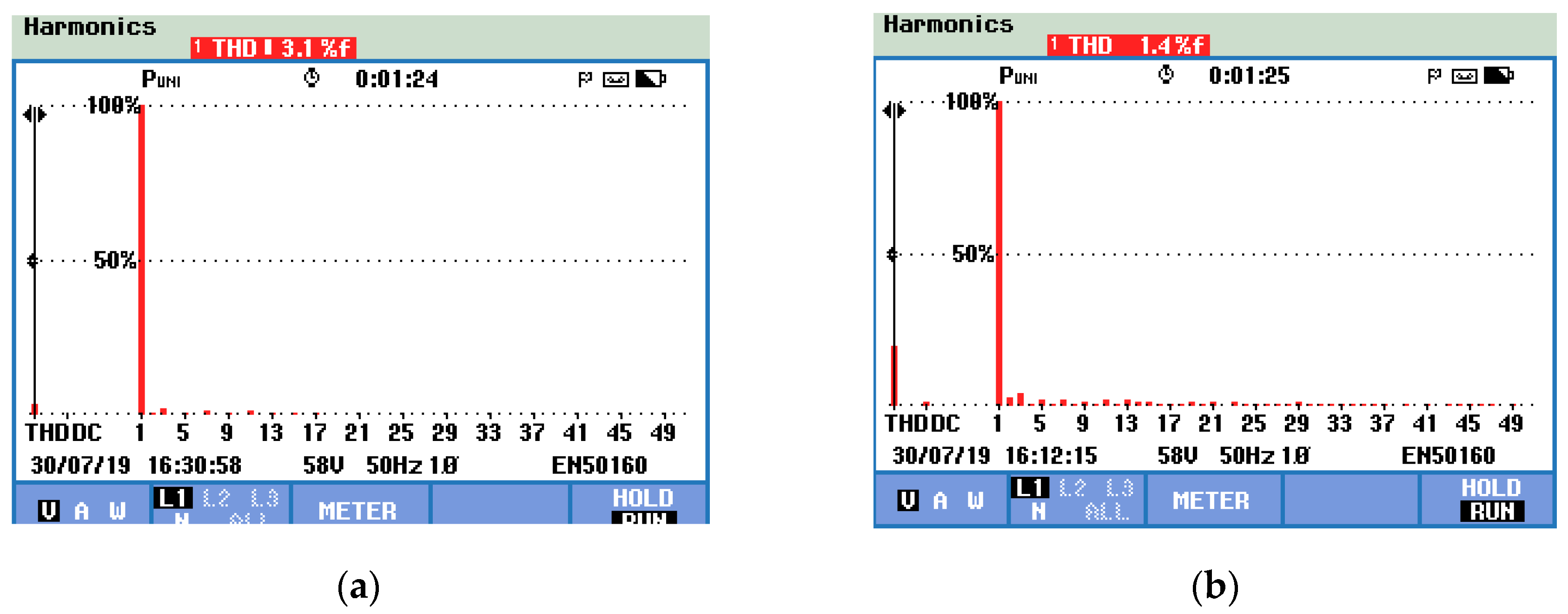
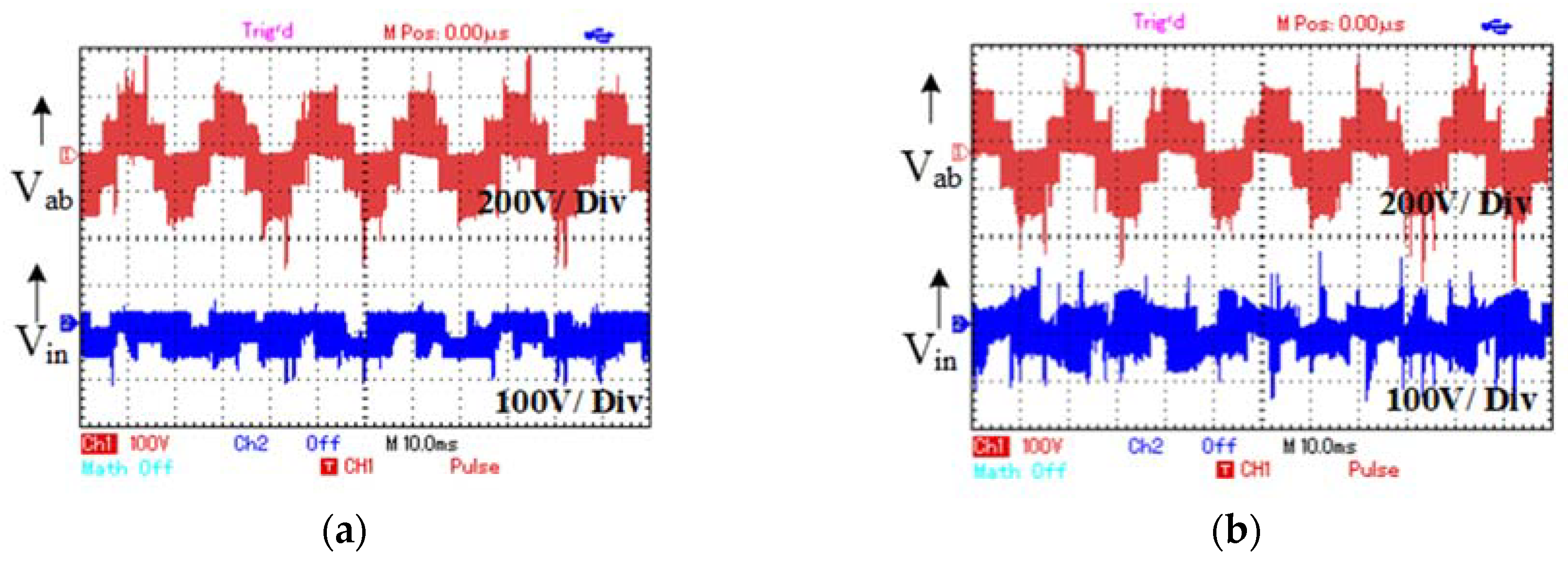
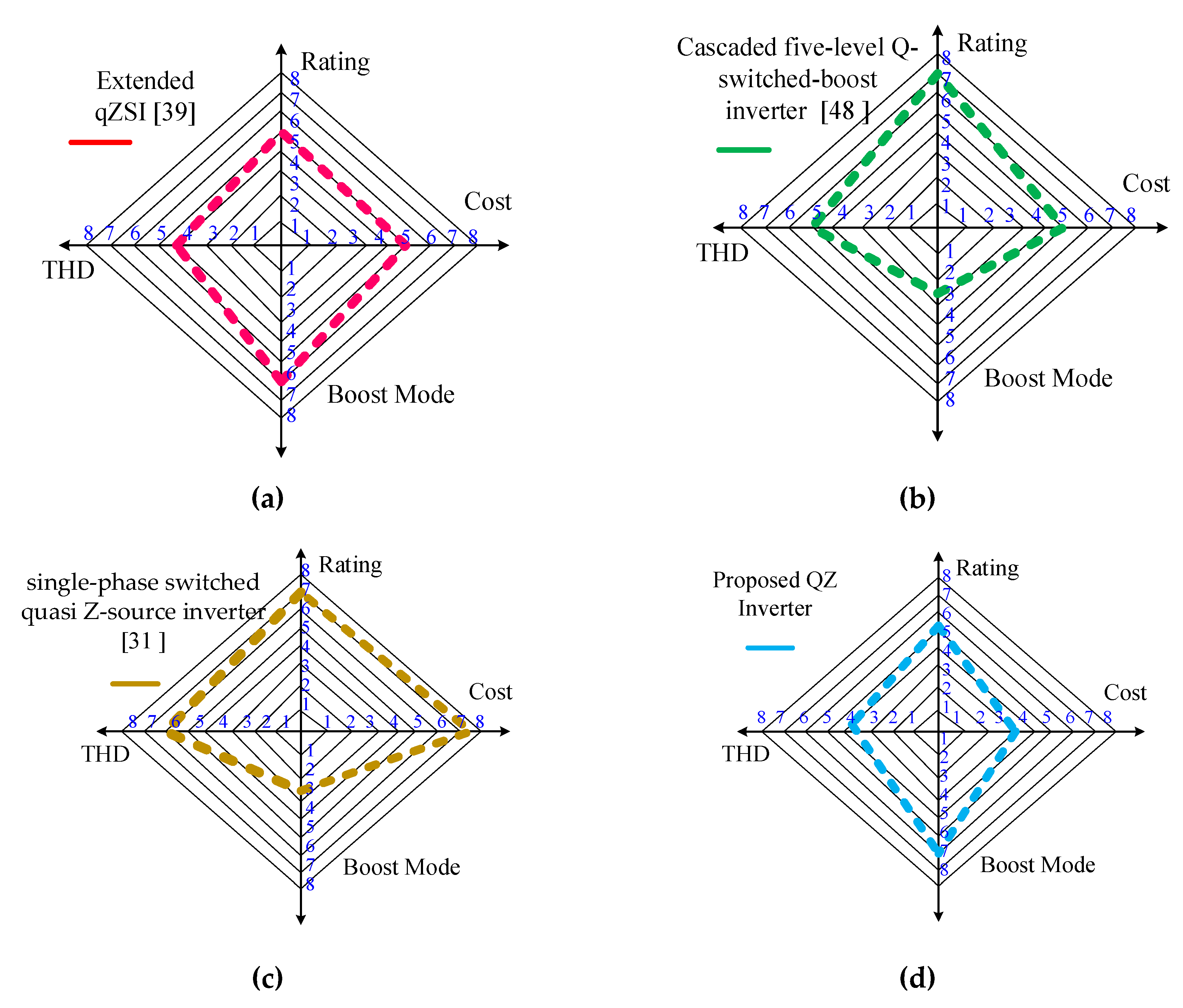
| Mode | Conducting Switches | Output |
|---|---|---|
| 1 | S1, S4, S6 | |
| 2 | S1, S4, S5 | |
| 3 | S1, S3, S6 | |
| 4 | S1, S3, S5 | |
| 5 | S2, S4, S6 | |
| 6 | S2, S4, S5 | |
| 7 | S2, S3, S6 | |
| 8 | S2, S3, S5 |
| Input PV Voltage, VPV | 100 V–120 V |
|---|---|
| Impedance Network Inductor Ls = L2 = L3 | 2 mH |
| Impedance network inductor capacitors C1 = C2 | 200 µF |
| Switching frequency, fs | 10 KHz |
| Inverter coupled inductor LM1 = LM2 | 5 mH |
| Mutual inductance | 2.4 mH |
| Load resistance and inductance | 10Ω, 5 mH |
| LC filter: inductance and capacitor | 2.5 mH,50 µF |
| DST | Vin | Vo = VDC-link | Vab for ma = 0.86 | % THD Vab for ma = 0.86 | Vab for ma = 0.60 | % THD Vab for ma = 0.60 |
|---|---|---|---|---|---|---|
| 0 | 120 | 120 | 86.4 V | 13.6% | 59.3 V | 12.6% |
| 10% | 120 | 177 | 125.6 V | 13.9% | 88.5 V | 13.8% |
| 15% | 120 | 210 | 149.2 V | 14.06% | 99.1 V | 13.8% |
| 20% | 120 | 280 | 197.4 V | 14.11% | 135.3 V | 13.54% |
| 25% | 120 | 349 | 247.3 V | 14.15% | 166.7 V | 14.06% |
| 30% | 120 | 410 | 291.7 V | 19.55% | 201.6 V | 17.32% |
| DST | Vin | Vo = VDC-link | Vab for ma =0.86 | % THD Vab for ma =0.86 | Vab for ma =0.60 | % THD Vab for ma =0.60 |
|---|---|---|---|---|---|---|
| 0 | 120 | 120 | 85.1 V | 2.69% | 57.2 V | 2.61% |
| 10% | 120 | 177 | 123.9 V | 2.71% | 86.9 V | 2.68% |
| 15% | 120 | 210 | 147.1 V | 2.72% | 97.4 V | 2.72% |
| 20% | 120 | 280 | 195.9 V | 2.77% | 133.9 V | 2.74% |
| 25% | 120 | 349 | 241.2 V | 2.81% | 164.9 V | 2.79% |
| 30% | 120 | 410 | 291.7 V | 3.83% | 200.1 V | 3.68% |
| DST | Switching Loss in Watts | Conduction Loss in Watts | Inverter Efficiency in % | THD in %(without Filter) | THD in %(with Filter) |
|---|---|---|---|---|---|
| 10% | 6.4 | 15.2 | 95.68% | 13.9% | 2.72% |
| 20% | 9.4 | 16.6 | 94.8% | 14.11% | 2.77% |
| 30% | 15.2 | 17.3 | 93.5% | 19.55% | 3.83% |
| Topology Proposed in | Number of Passive Elements Used | Number of Switches Used | A Coupled Inductor or Transformer Type | Maximum Achievable Voltage Gain in % | |
|---|---|---|---|---|---|
| L | C | ||||
| [39] | 2 | 2 | 6 | Coupled inductor | ≤ 2 times |
| [6] | 2 | Intergraded winding | 8 | NA | ≤ 2 times |
| [45] | 4 | 2 | 2 only for converter | Coupled inductor | ≥ 2 times |
| [46] | 4 | 4 | 8 | NA | |
| [47] | 4 | 4 | 8 | NA | ≤ 2 times |
| [48] | 2 | 2 | 10 | NA | ≤ 2 times |
| Proposed QZ Inverter | 3 | 2 | 6 | Coupled inductor | ≥ 2 times |
© 2020 by the authors. Licensee MDPI, Basel, Switzerland. This article is an open access article distributed under the terms and conditions of the Creative Commons Attribution (CC BY) license (http://creativecommons.org/licenses/by/4.0/).
Share and Cite
Periyanayagam, M.; Kumar V, S.; Chokkalingam, B.; Padmanaban, S.; Mihet-Popa, L.; Adedayo, Y. A Modified High Voltage Gain Quasi-Impedance Source Coupled Inductor Multilevel Inverter for Photovoltaic Application. Energies 2020, 13, 874. https://doi.org/10.3390/en13040874
Periyanayagam M, Kumar V S, Chokkalingam B, Padmanaban S, Mihet-Popa L, Adedayo Y. A Modified High Voltage Gain Quasi-Impedance Source Coupled Inductor Multilevel Inverter for Photovoltaic Application. Energies. 2020; 13(4):874. https://doi.org/10.3390/en13040874
Chicago/Turabian StylePeriyanayagam, Madasamy, Suresh Kumar V, Bharatiraja Chokkalingam, Sanjeevikumar Padmanaban, Lucian Mihet-Popa, and Yusuff Adedayo. 2020. "A Modified High Voltage Gain Quasi-Impedance Source Coupled Inductor Multilevel Inverter for Photovoltaic Application" Energies 13, no. 4: 874. https://doi.org/10.3390/en13040874
APA StylePeriyanayagam, M., Kumar V, S., Chokkalingam, B., Padmanaban, S., Mihet-Popa, L., & Adedayo, Y. (2020). A Modified High Voltage Gain Quasi-Impedance Source Coupled Inductor Multilevel Inverter for Photovoltaic Application. Energies, 13(4), 874. https://doi.org/10.3390/en13040874








